-
Posts
1,780 -
Joined
-
Last visited
-
Days Won
8
Content Type
Profiles
Forums
Blogs
Gallery
Events
Store
Posts posted by azyeoman
-
-
Sweet! I love sake cups, though I only collect those of the Russo-Japan War flavor. Cups are especially cool when they have names on them and even better when you can get the boxes! Nice collection!
Nice Nagoya rifle too. Does the dust cover number match too? If so, super-tasty!!

Thank you. I know some of them have names, but I can't read Japanese. Regarding the Nagoya rifle, every number matches! :-)
0 -
A nice WWI PoW related postcard appealing for donations for Kent PoWs.
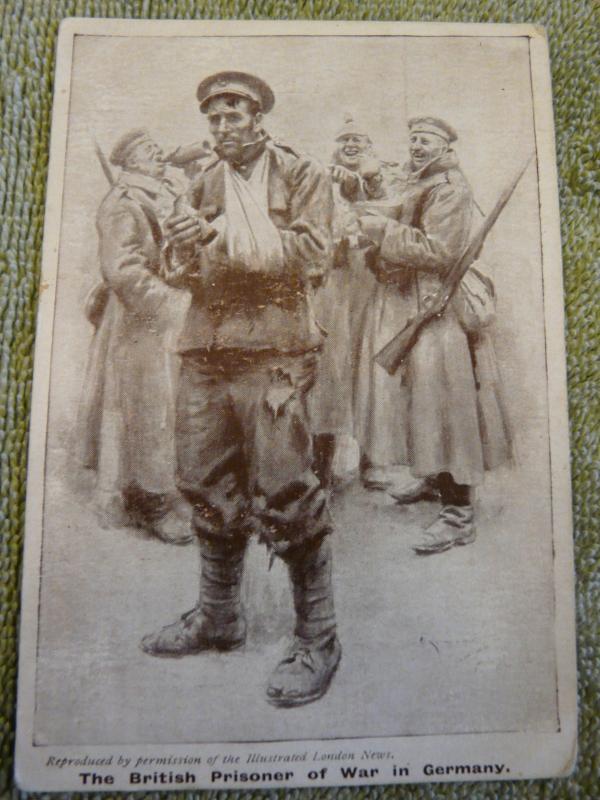
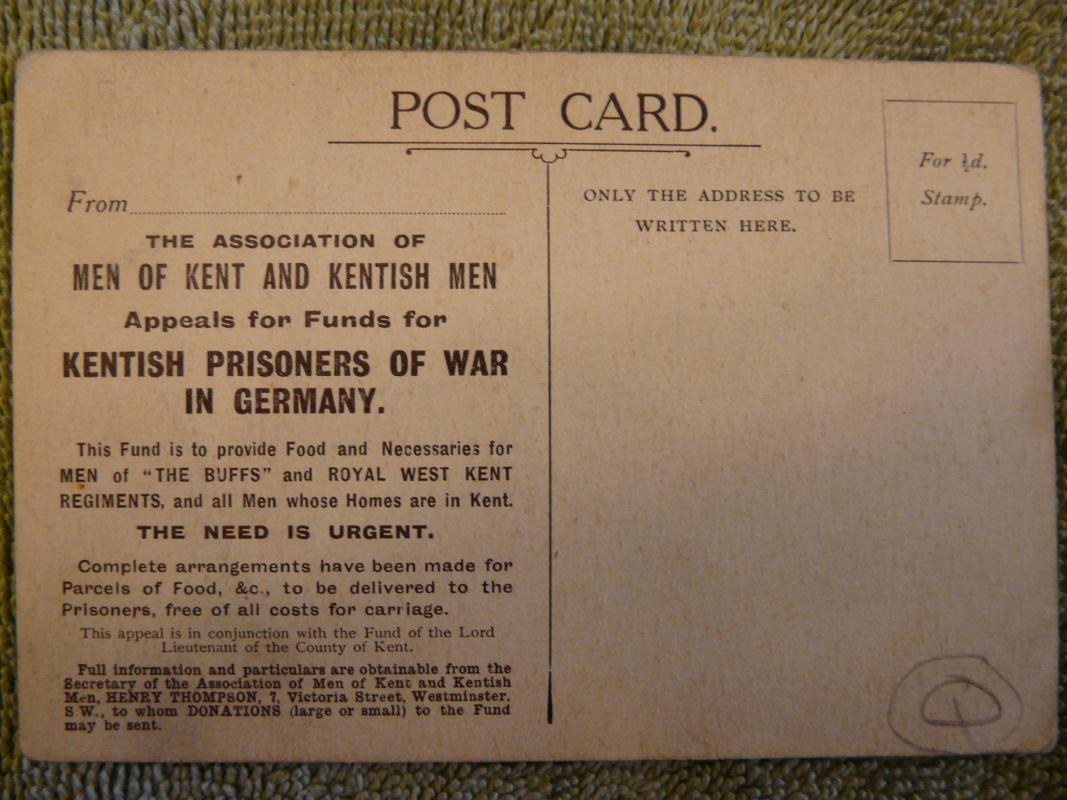 0
0 -
The latest addition is an antique Japanese army sake cup, decorated with a rising sun, a branch of cherry blossoms, and the words "Term Fulfillment commemoration". The words on the back are "27th Infantry Regiment" and the soldier's name Hurukawa. The cup is boxed in an original wooden box and there's a full name Takahashi Kanbei on a slip who might be the person who ordered it.
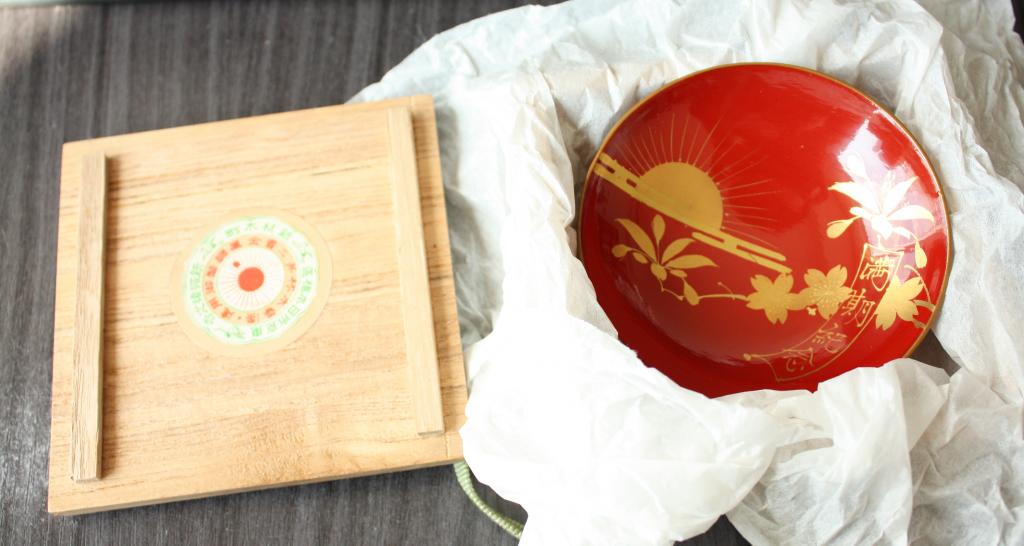
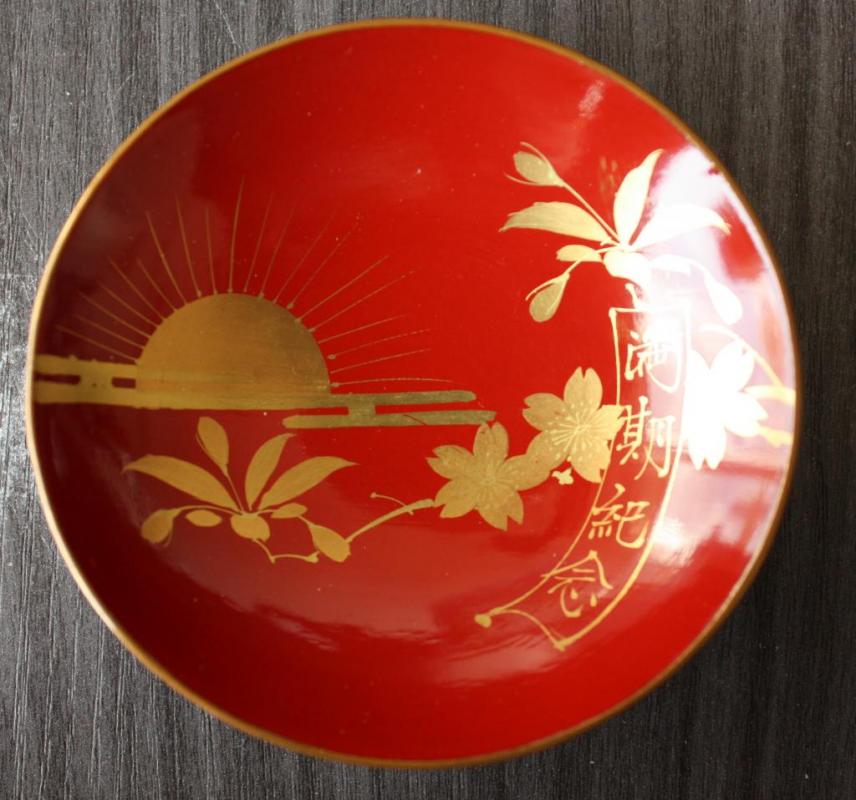
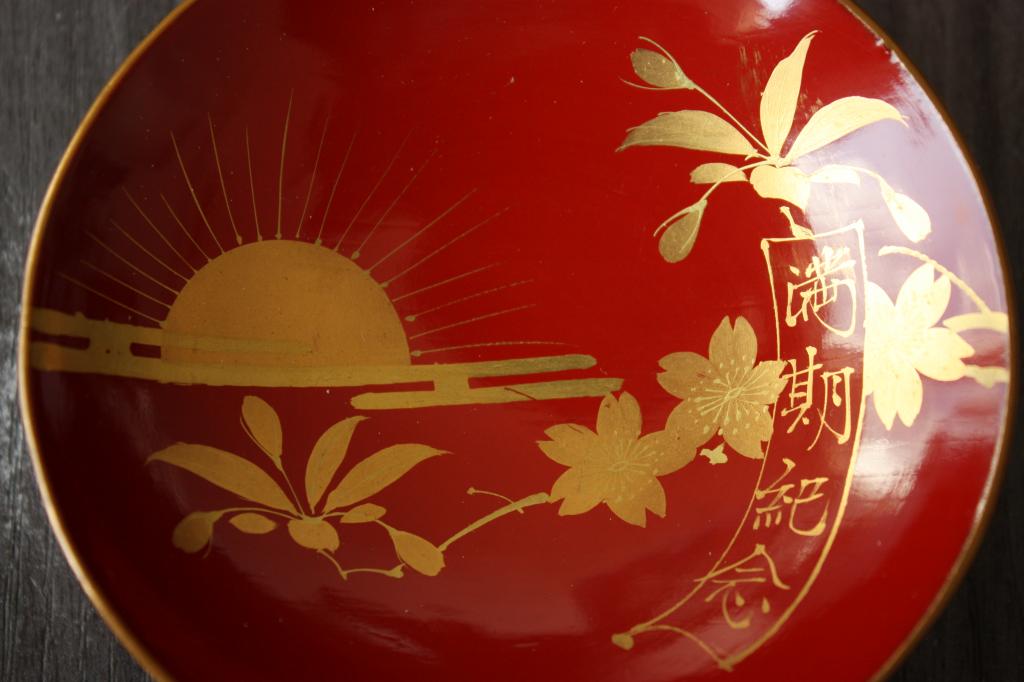
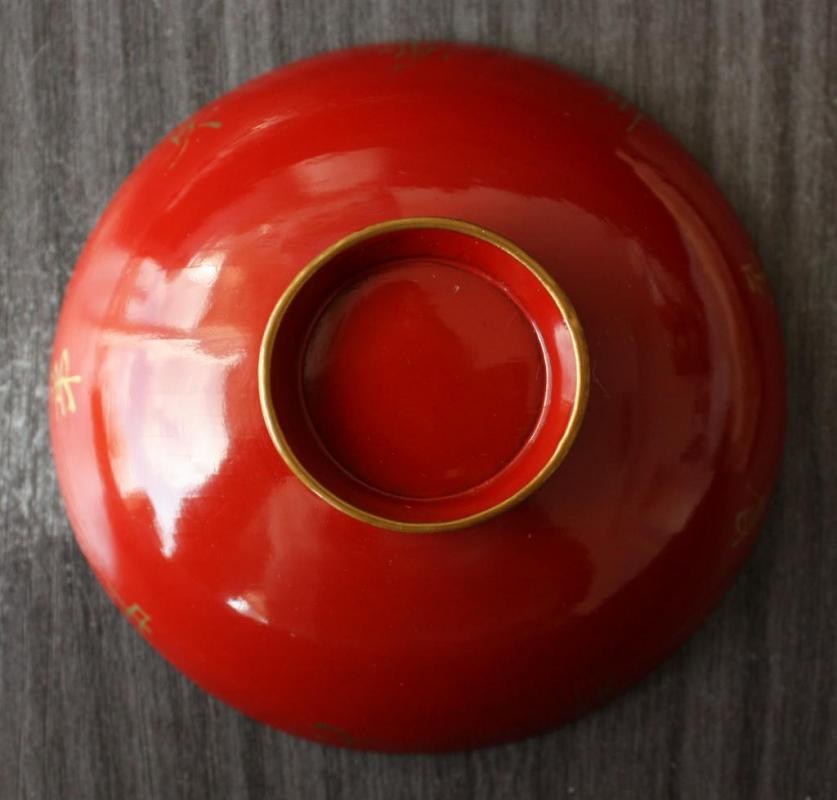
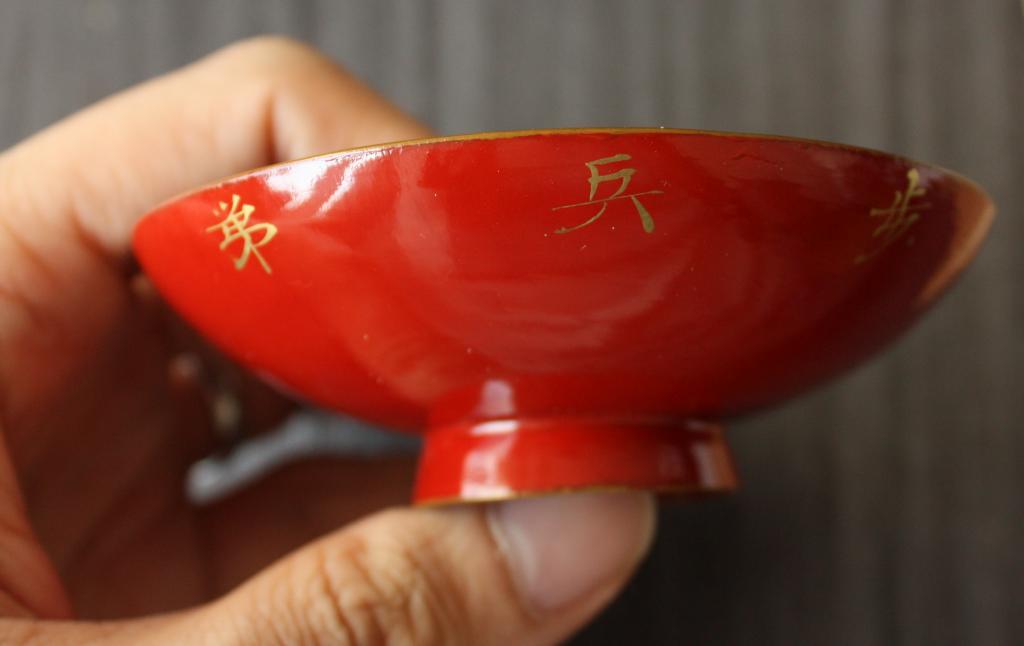
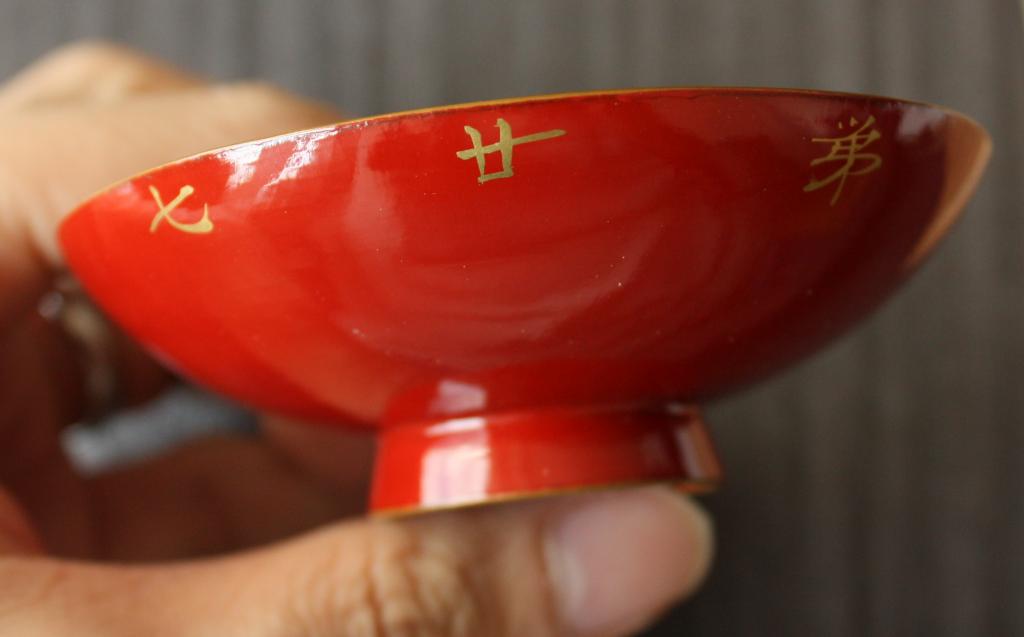

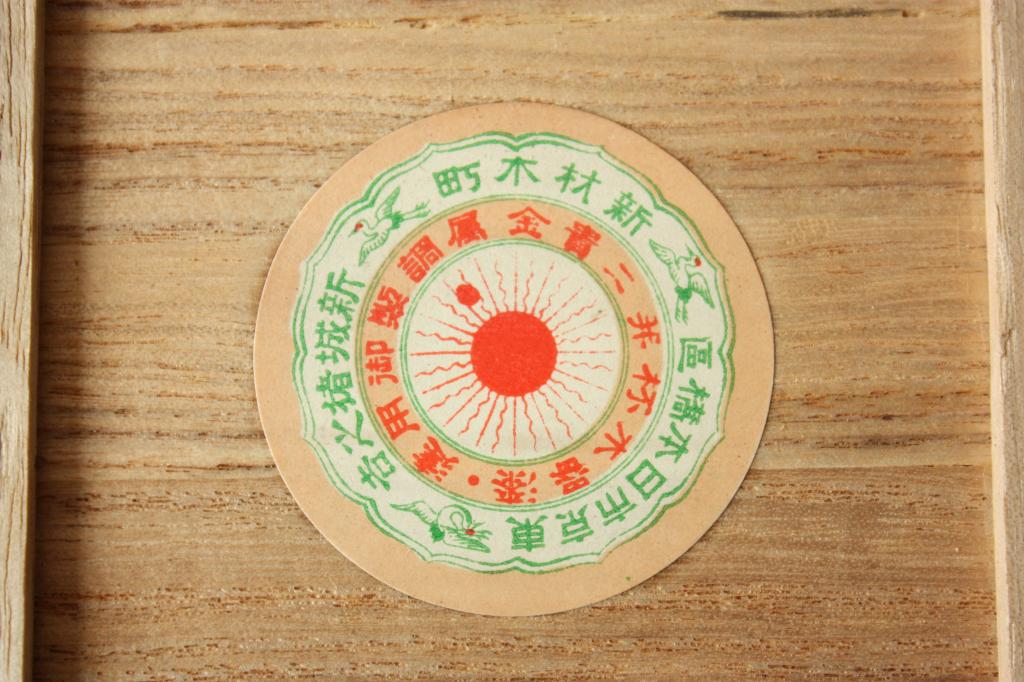
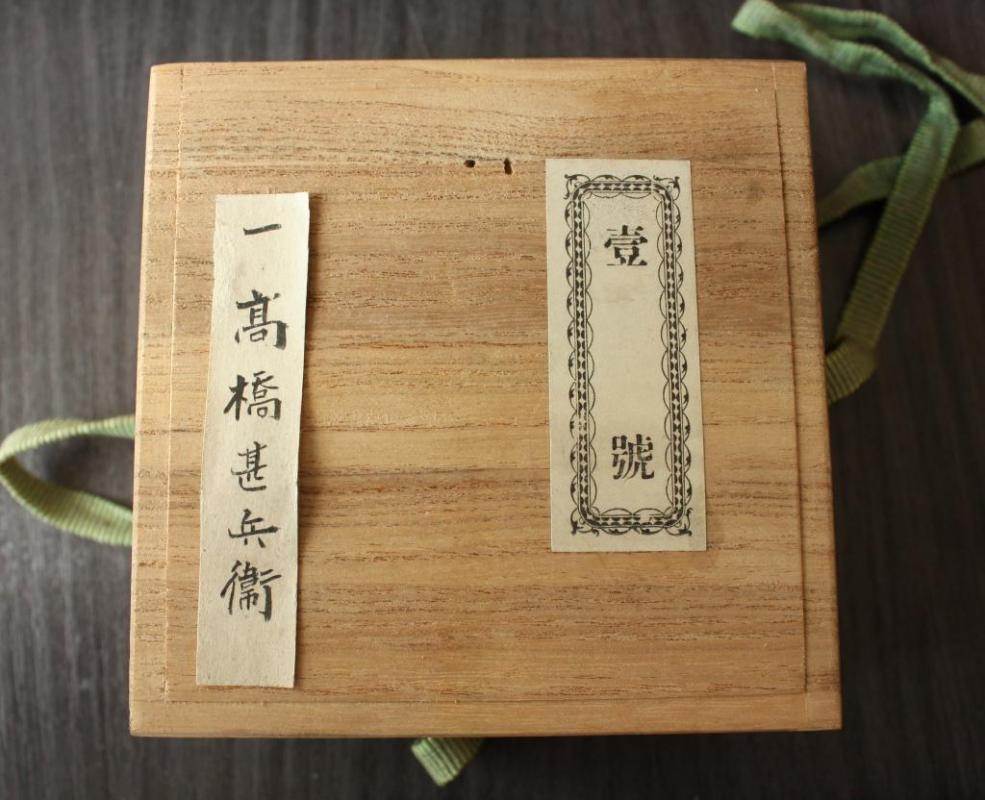 0
0 -
The last of the collection... all matching numbers on the rifle (down to the firing pin!) and brought home during the war by a US pilot who flew the hump. If anyone can translate the Kanji on the helmet, I'd be very apprciative.

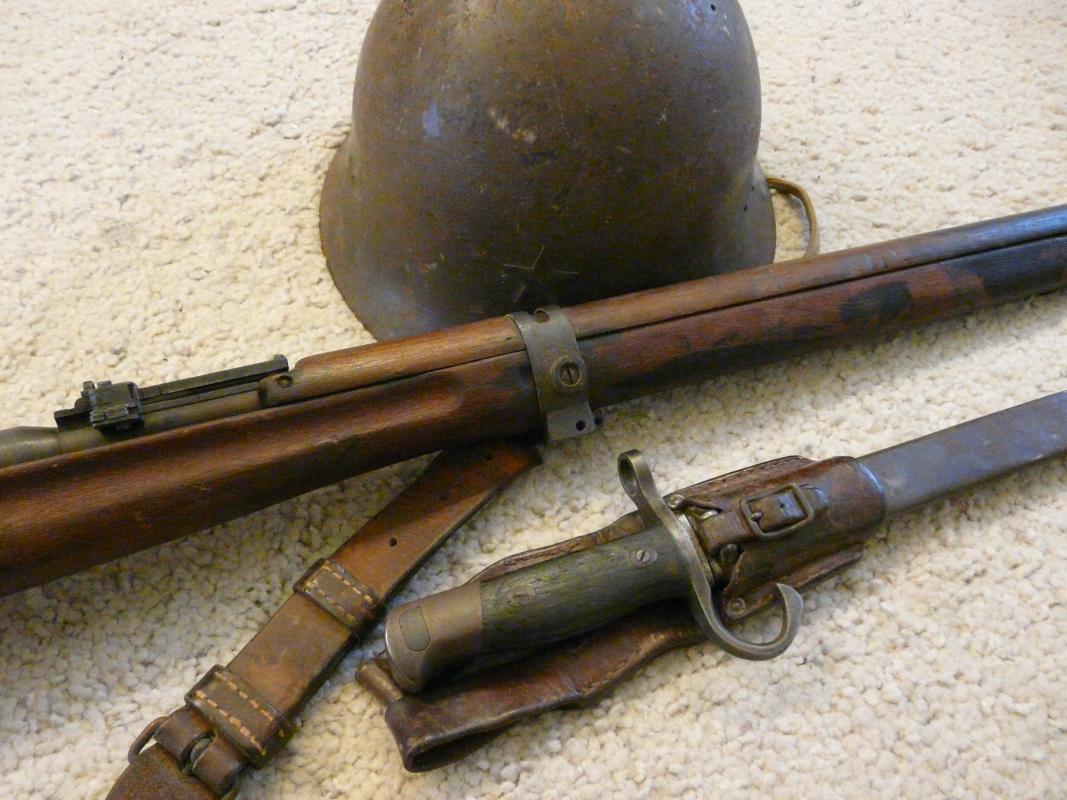
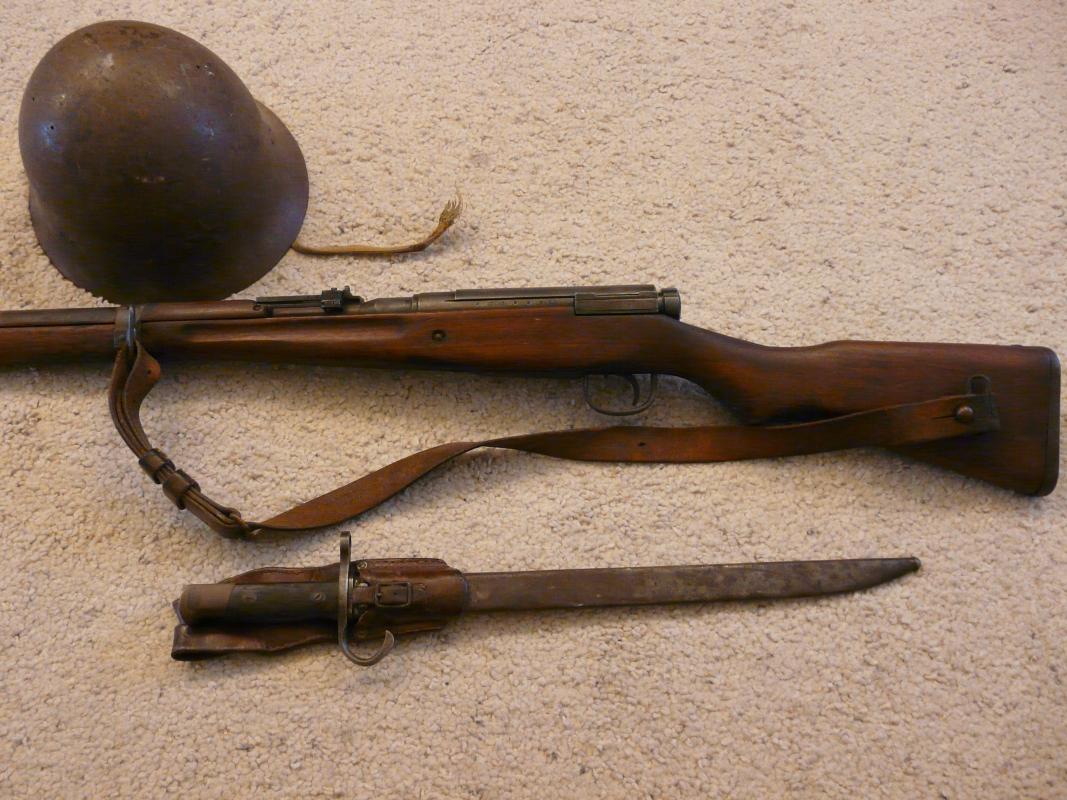
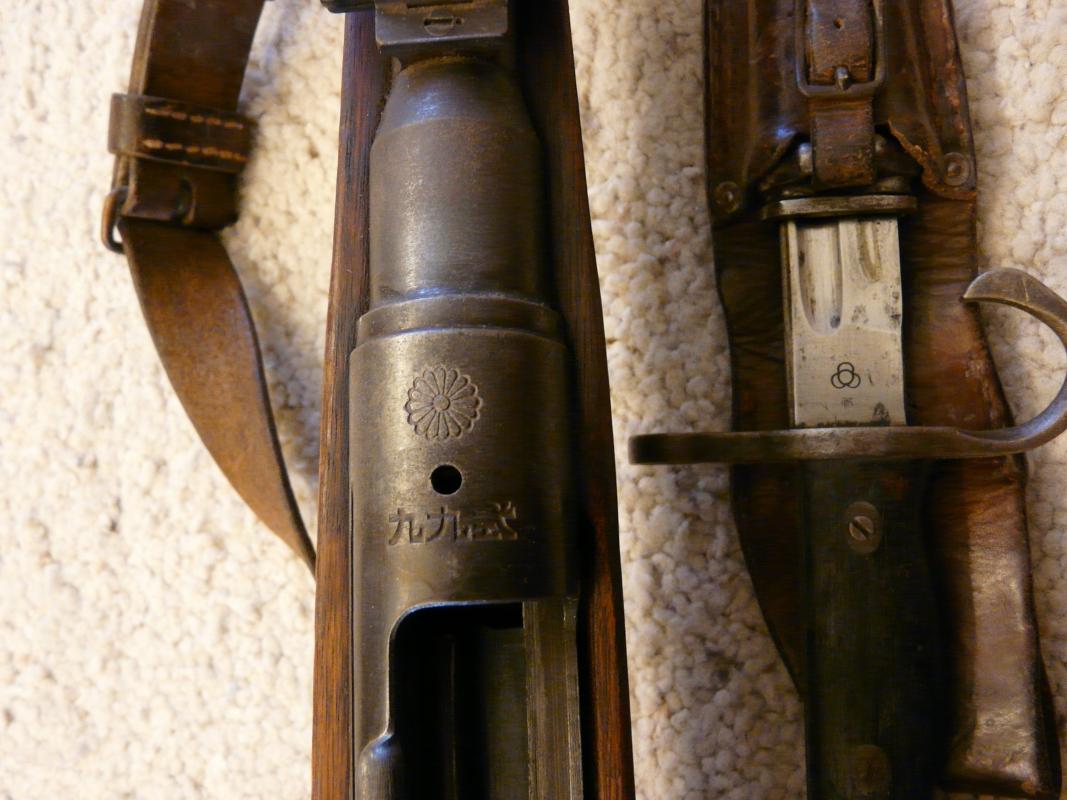
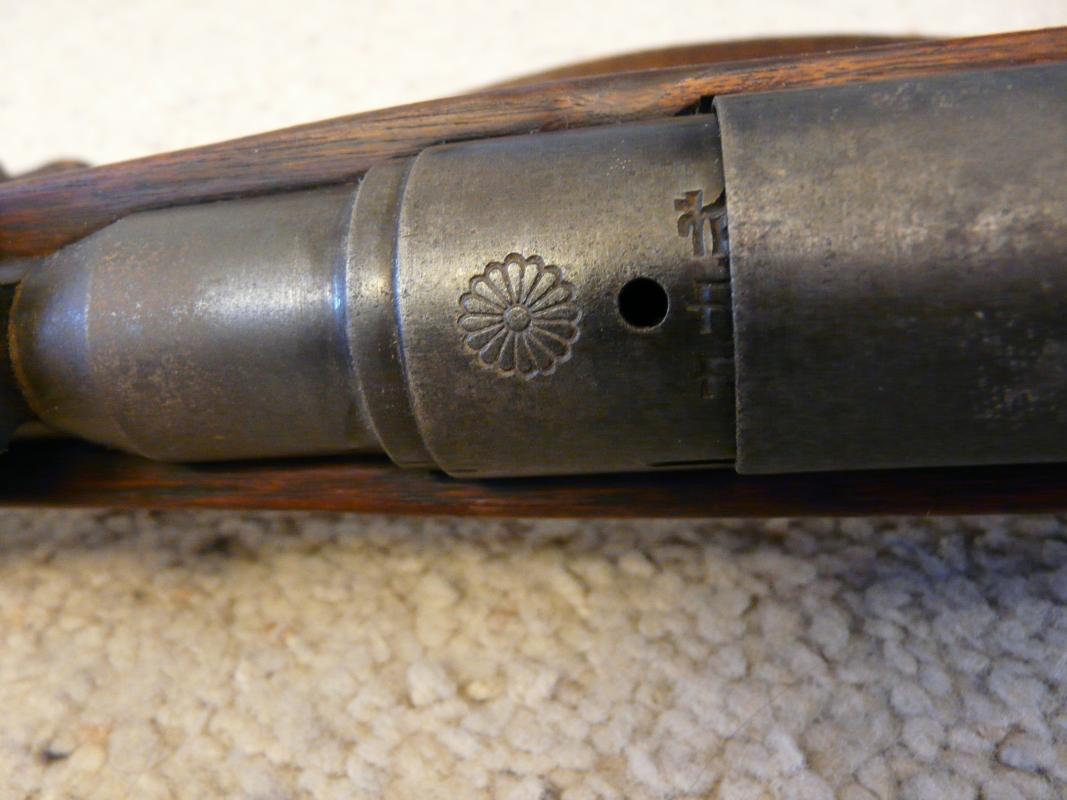


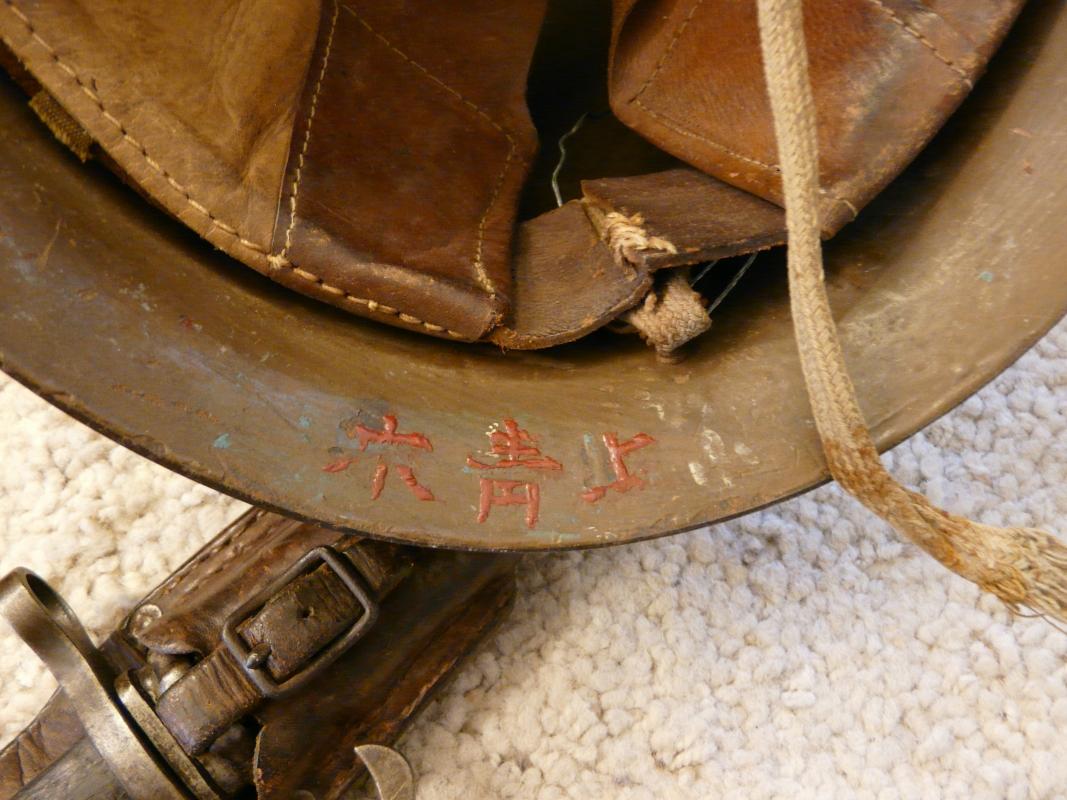 0
0 -
A WWII Japanese collection wouldn't be complete without a signed flag. This one has the following written on it.
"Good luck for Bravery"
"Believe firmly and serve your country."
"Seven lives, serve your country seven times."
Mr. Sakata
Signatures from the entire Sakata family.

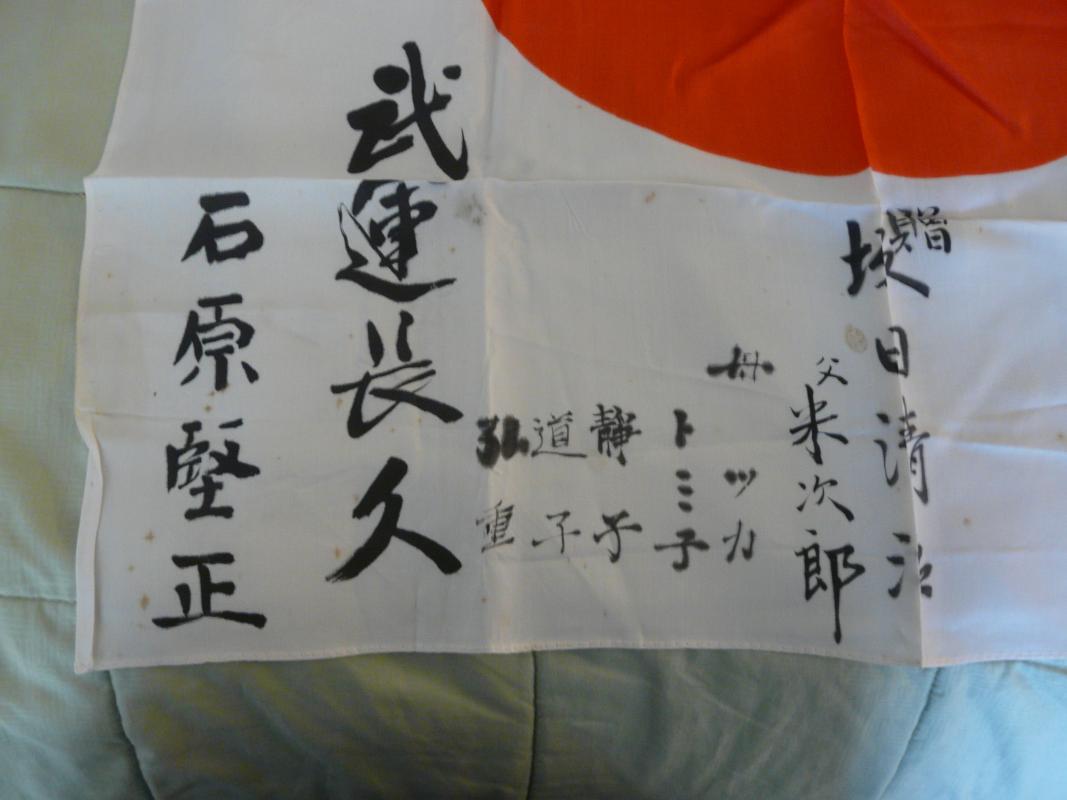
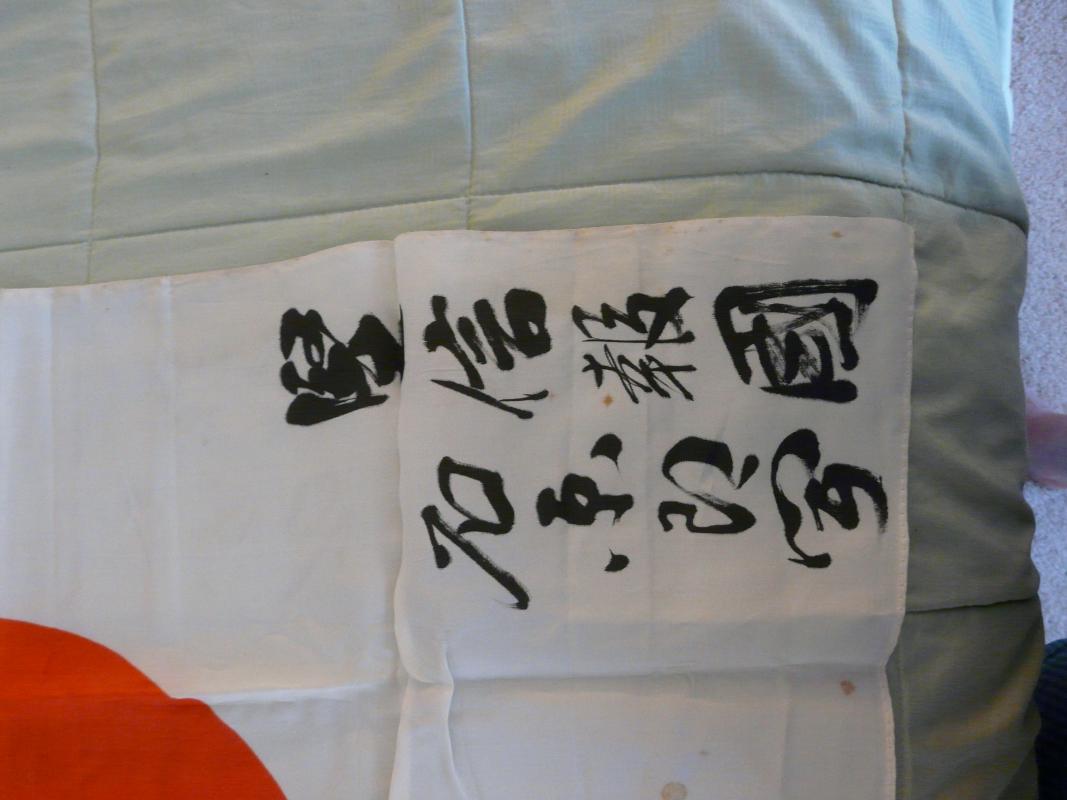
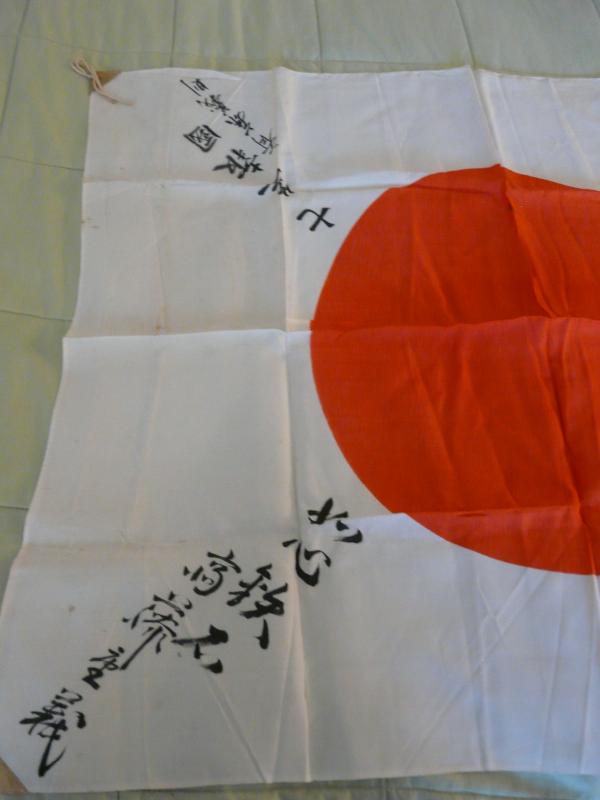 0
0 -
Some relics from Eniwetok in the Marshals. All brought home by the same man and never cleaned.
Maj. Gen. Yoshimi Nishida defended the atoll with 2,741 men and after the battle ended (17 Feb. - 23 Feb. 1944) only 48 labourers and 16 Japanese were captured. These were from someone who needless to say, wasn't captured. The US had 262 killed, 77 missing and 757 wounded. Eniwetok provided an airfield and harbor to support attacks on the Marianas.
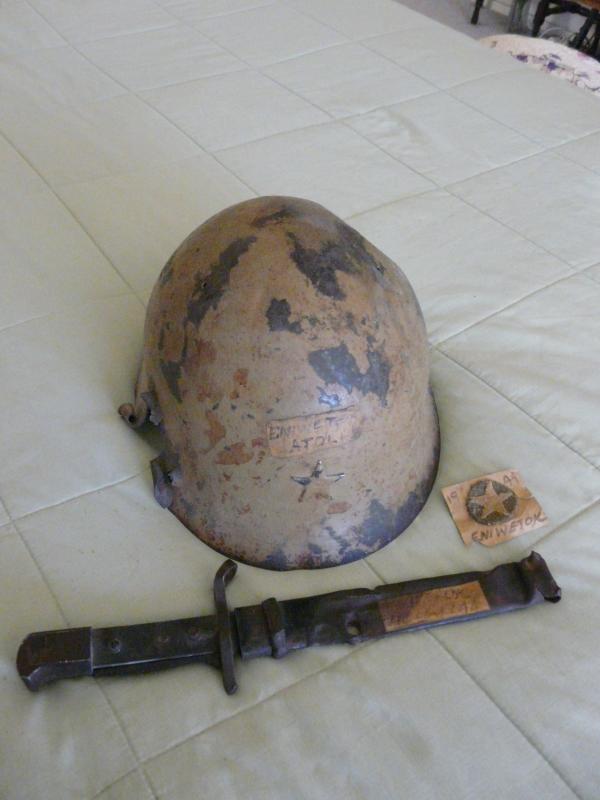 0
0 -
And some more. I particularly like the cranes on the very top of the rims of two of these.

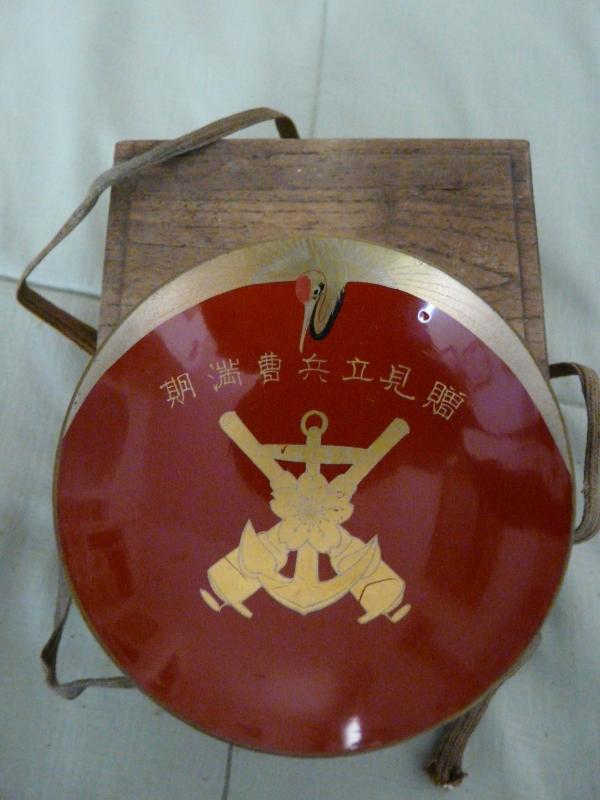
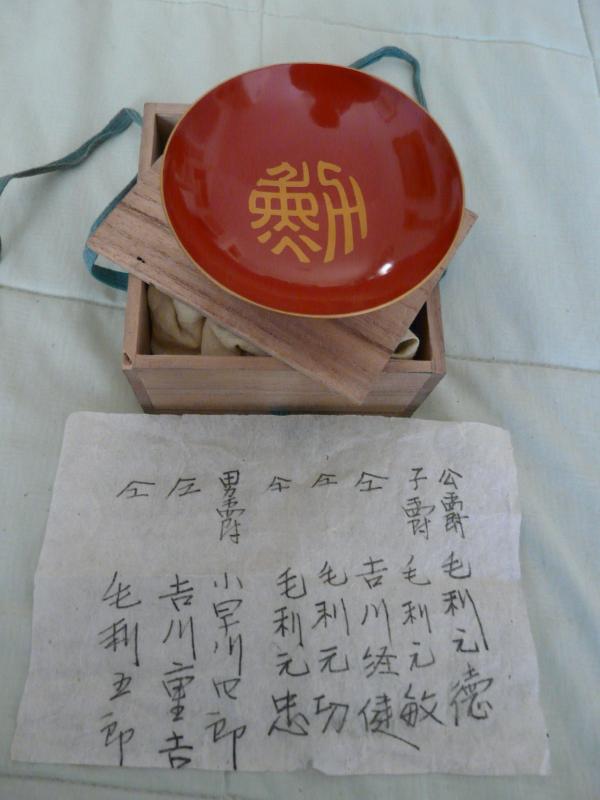
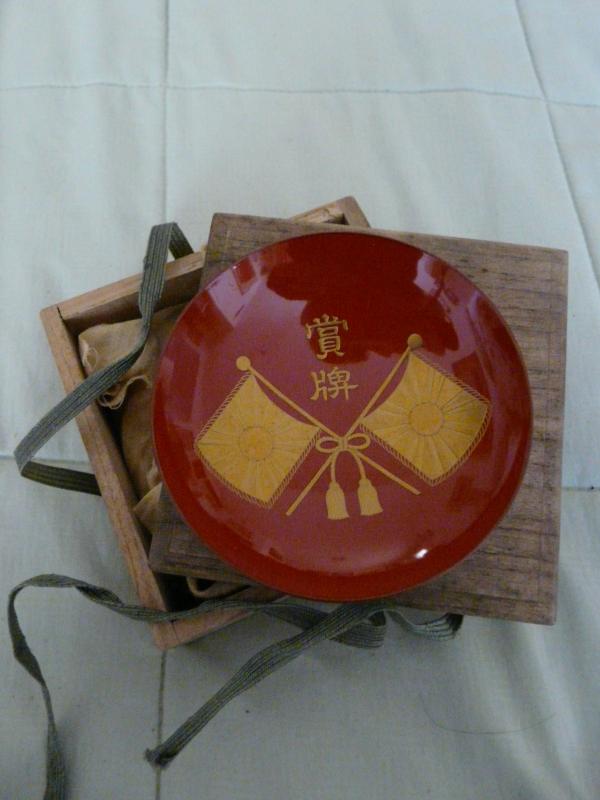
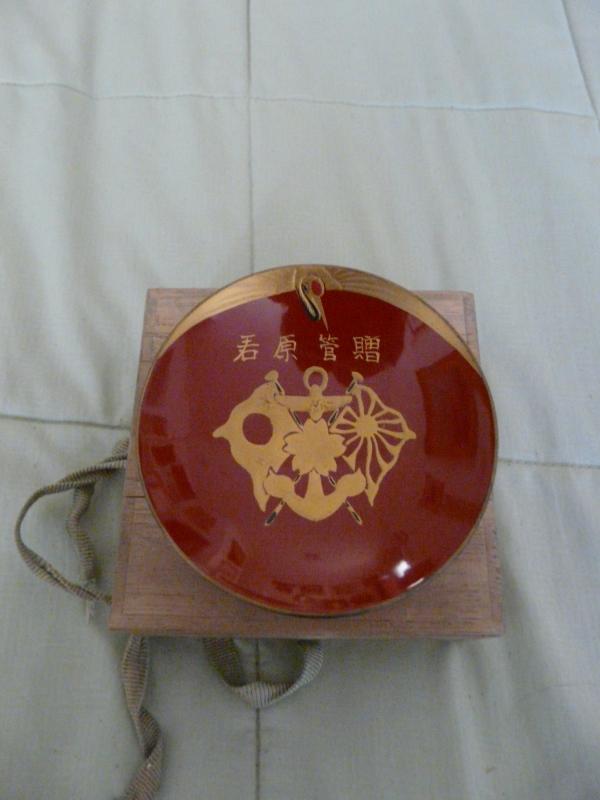
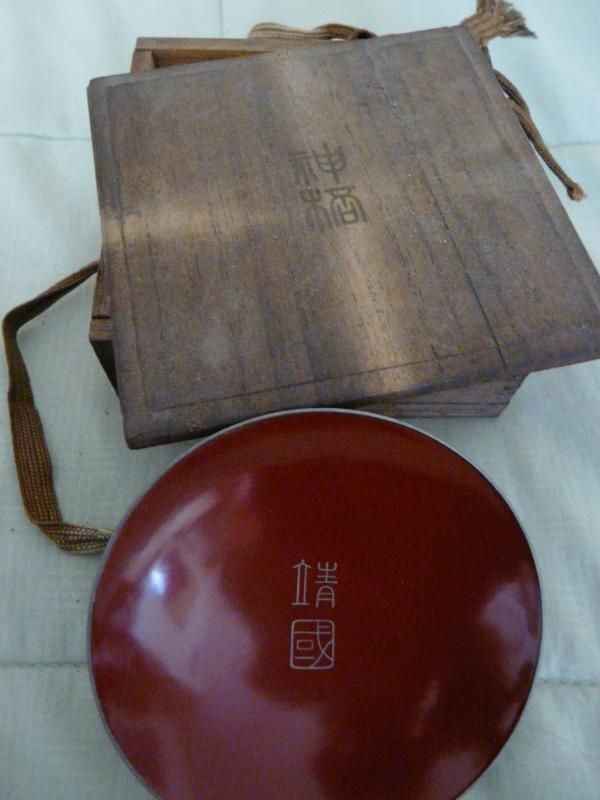 0
0 -
Here are some more sake cups etc. Hope you find them as interesting as I do. I only collect ones that are boxed.
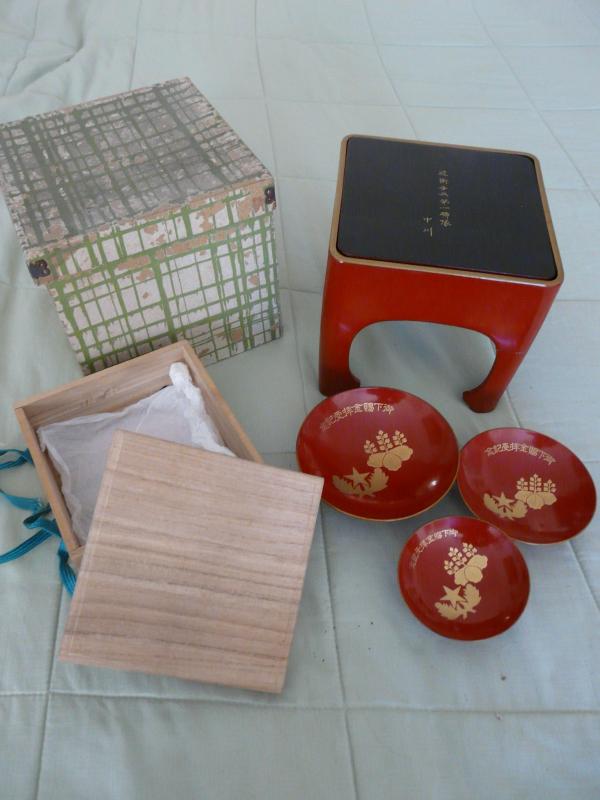
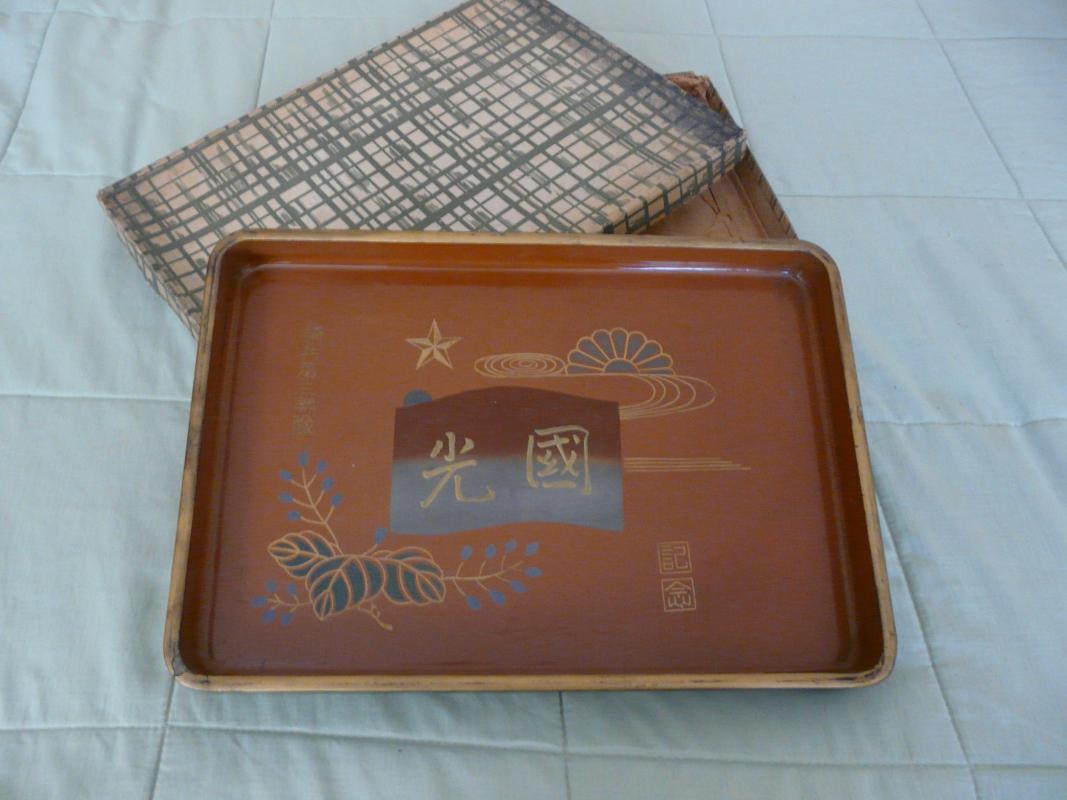
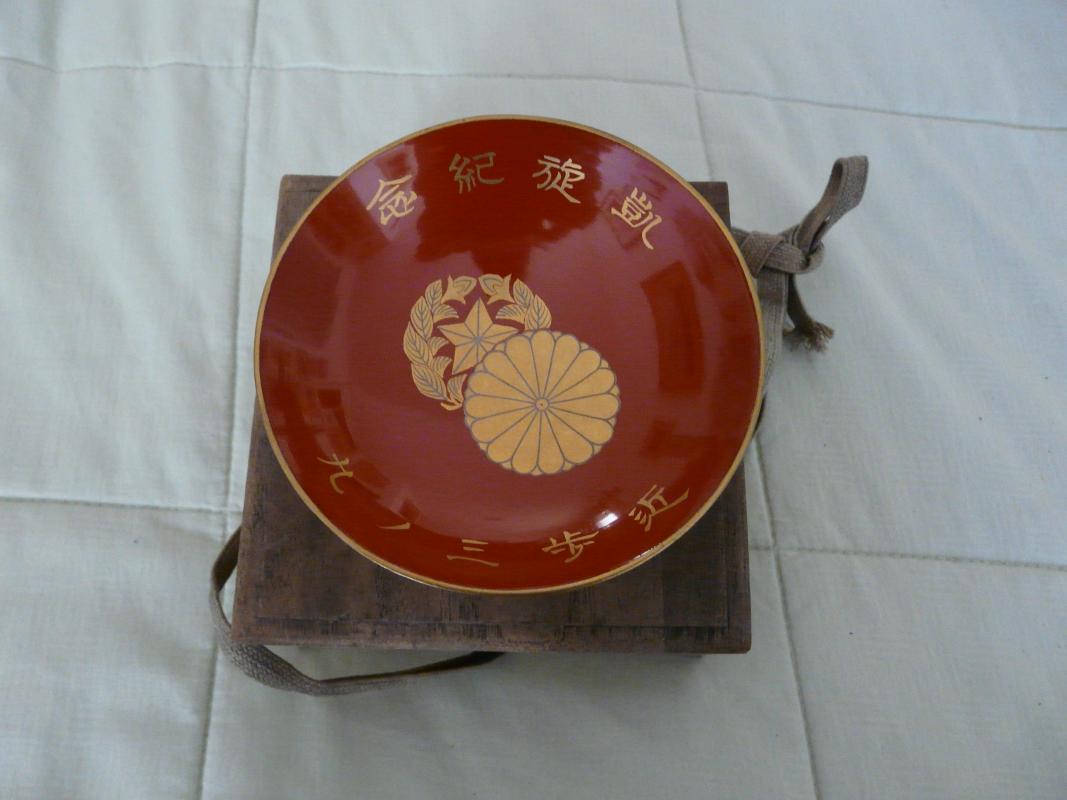
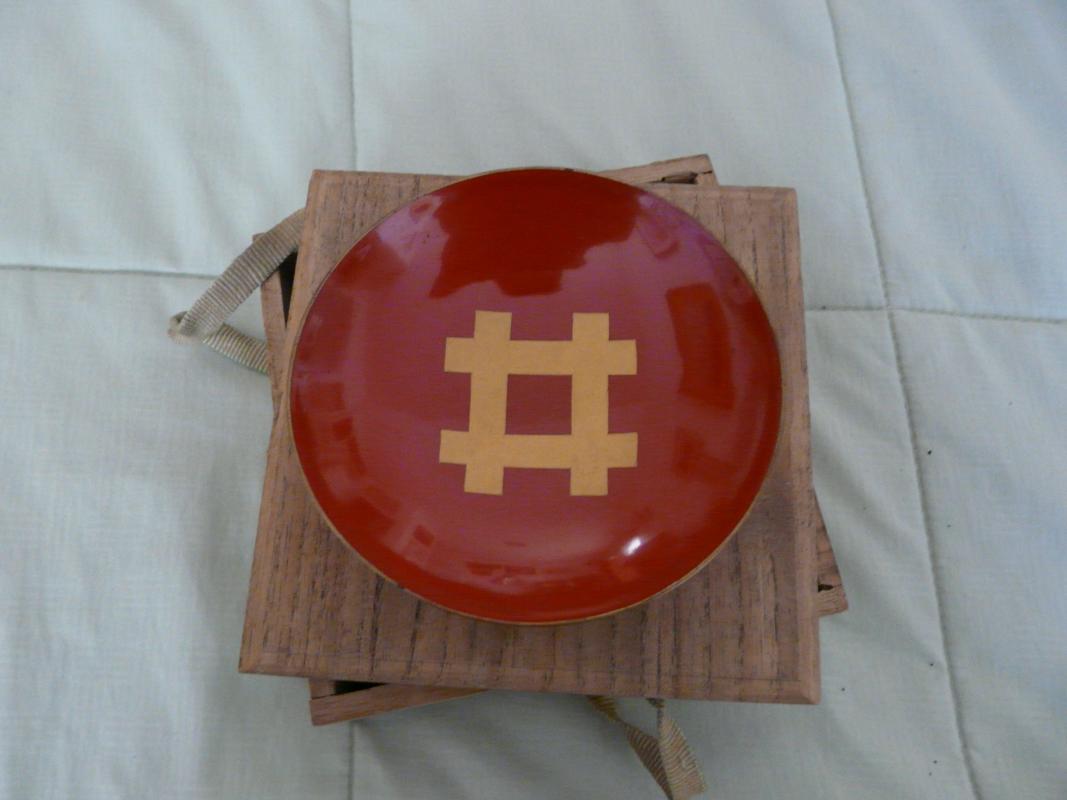
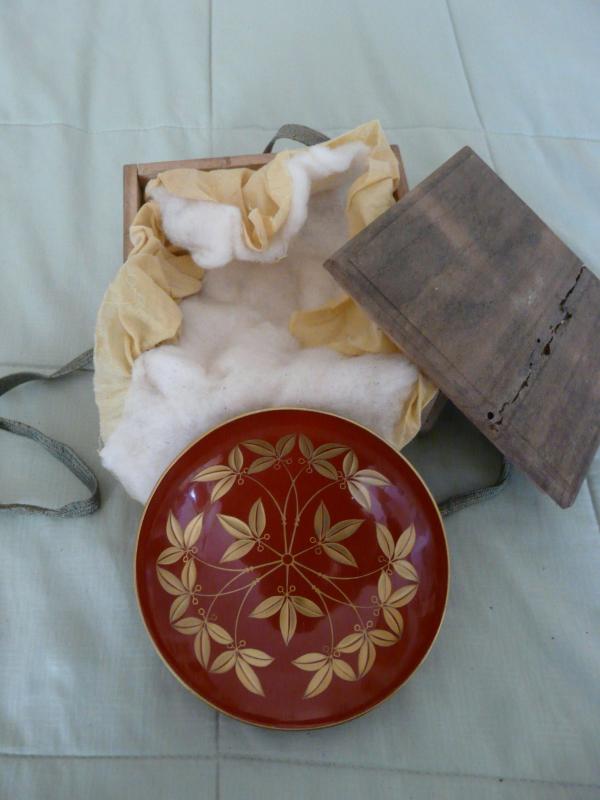
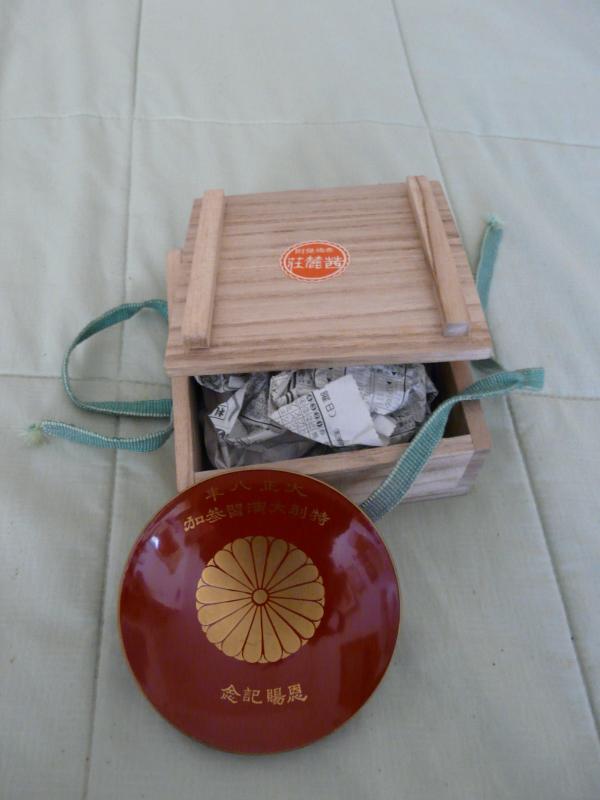 0
0 -
Lets keep this topic going! You all are posting some very interesting history and artifacts.
Thank you very much. I hope to, but as it's my collection, I'm limited to what's out there and what I can afford... Oh to be Bill Gates. ; )
0 -
I like these lacaquer Sake cups and their boxes. I've heard they can't be faked either. They are very artistic and aesthetically pleasing. I was fortunate to obtain an actual one that was used for an illustratipon in "The Book" on Japanese Military Sake Cups as shown below.

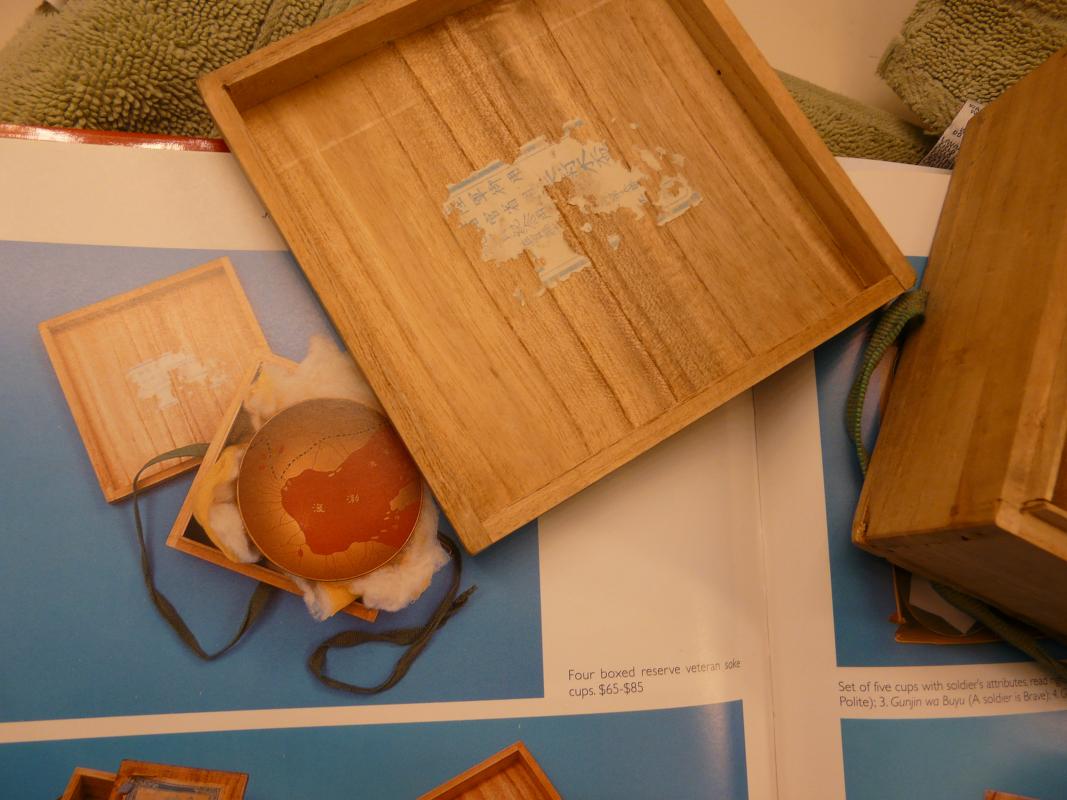
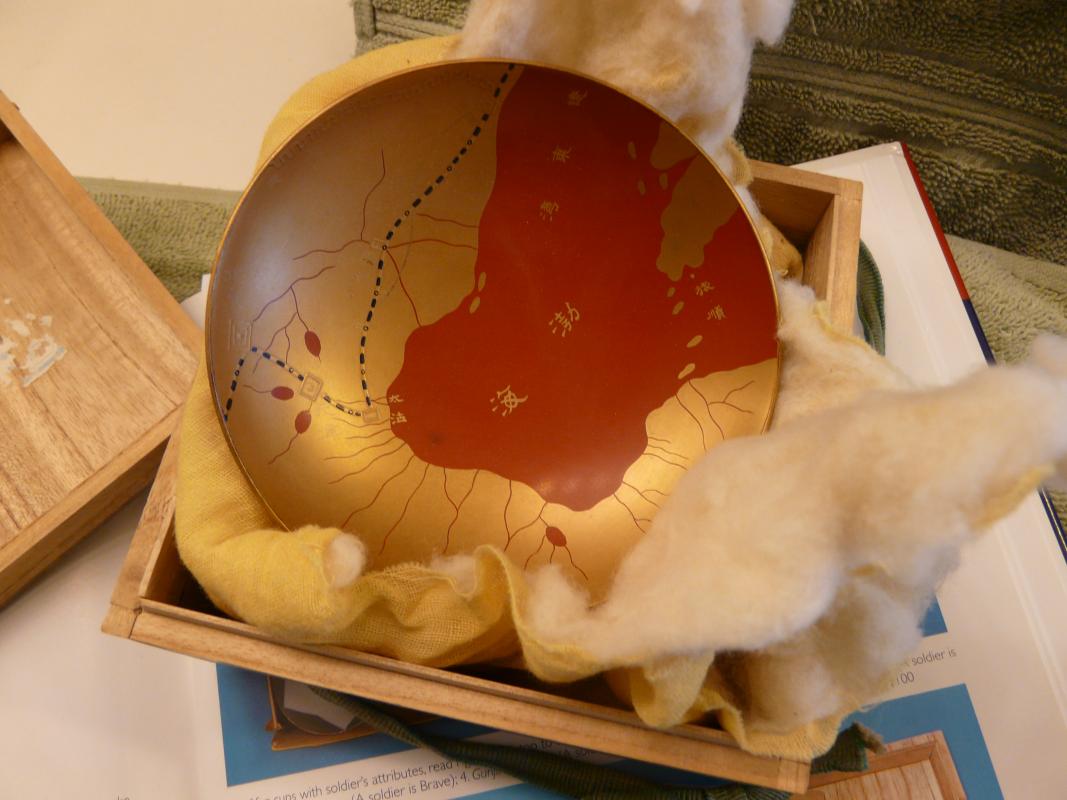

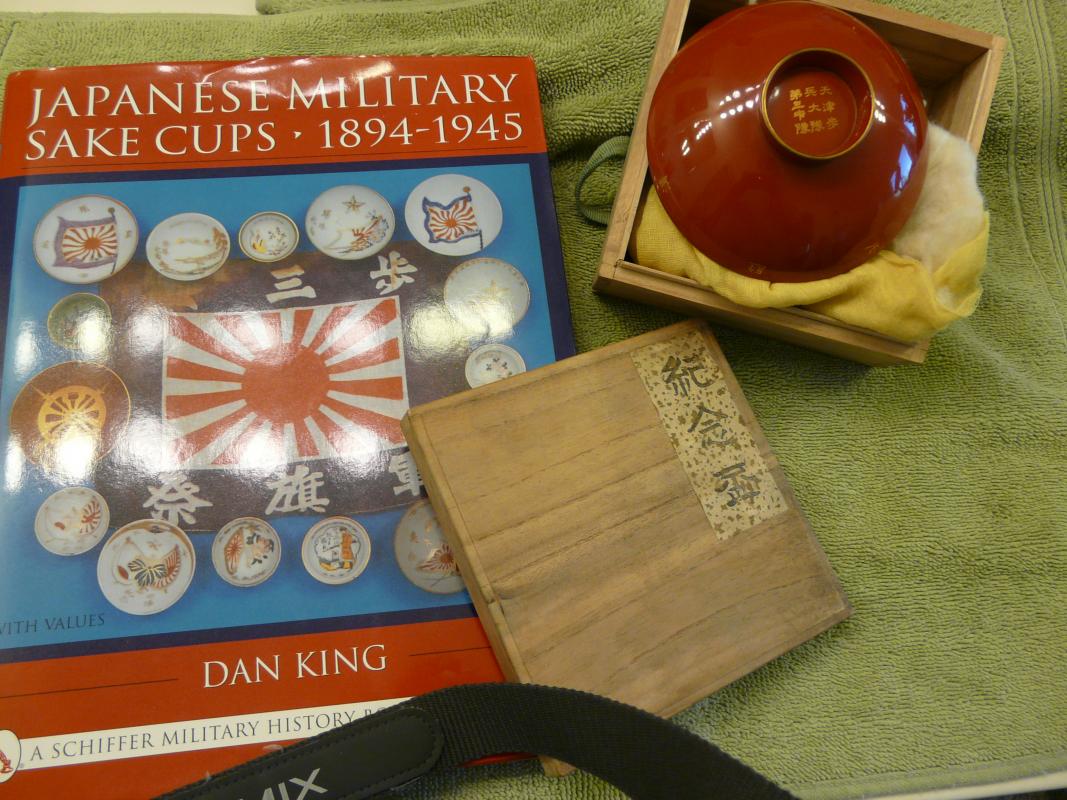
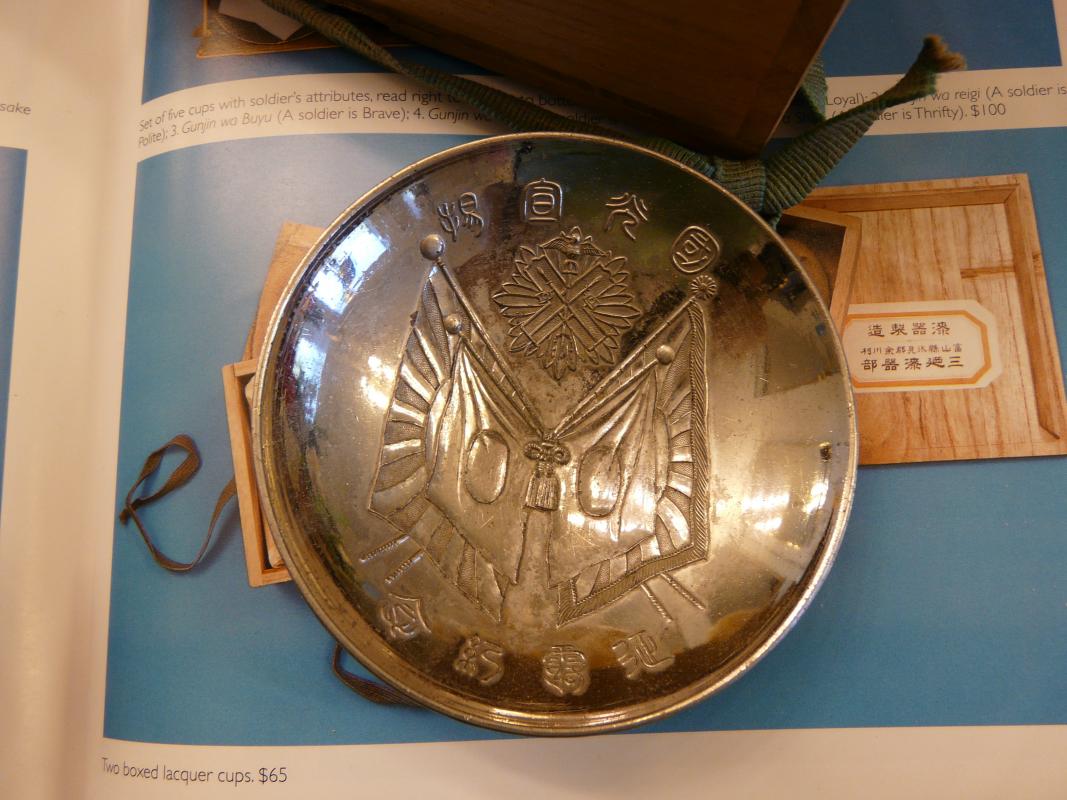
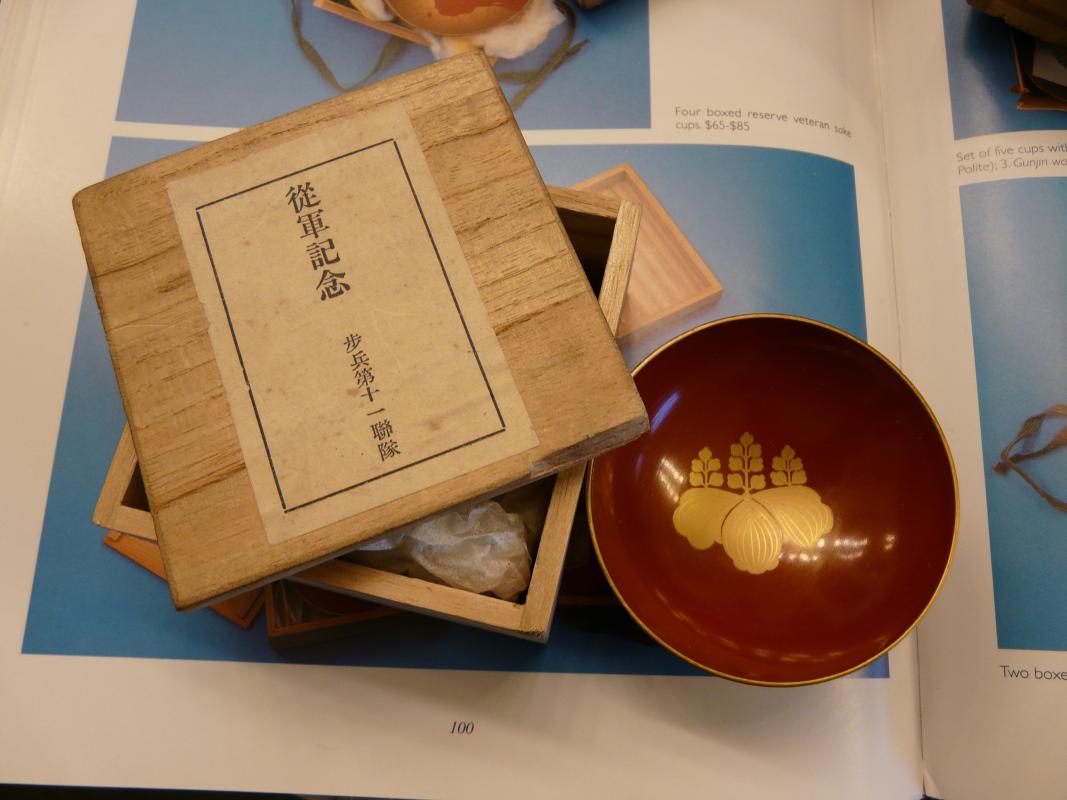 0
0 -
Those of you who want to check your Australian Vietnam Medals can use this site.
http://www.vietnamroll.gov.au/
0 -
I was very pleased to finally come across a Norway Campaign PoW; scarce to say the least.
WW2 Lincolnshire Regiment Norway Campaign 1940 PoW Death March Casualty GSM.
This General Service Medal, clasp Palestine was awarded to 4800228(9) Pte G.W. Thomas Linc R.
Please note the last digit of the regimental number on the medal is 8. The medal roll and casualty roll give the last digit as 9. The Palestine Medal Roll for the Regiment shows only one Pte G.W. Thomas serving with the Regiment and entitled to the GSM. There can be no doubt this is the medal of Pte George William Thomas who died on the death march.
Private George William Thomas, a pre war regular soldier was serving with the 2nd Battalion at the time of the award of the GSM. Transferring to the Reserve at the outbreak of the WW2 he was recalled and posted to the 4th Bn. This Battalion was dispatched to Norway and was the first major British Army unit to engage the German Army at Steinkjer, the Battalion was forced to withdraw with a number of casualties and it was then that Pte Thomas was most likely captured. In 1945 he, with other PoWs were on the Death March, the movement of Allied PoWs from the advancing Russian Army. Private Thomas was reported as died on the 19th April 1945 and now rests in Venray Military Cemetery Holland; Limburg, The Netherlands
The town of Venray lies in the south of the Netherlands approx 40kms to the east of Eindhoven.
From the A73 Nijmegen to Venlo motorway take exit 9 (Afrit 9) N270 VENRAY / HELMOND and follow the signs for HELMOND.
Continue for approx 3kms to a roundabout and turn right (CWGC sign) onto the LANGSTRAAT.
Continue for approx 800m and turn left (CWGC sign) onto the WESTSINGEL. Continue for approx 1km and turn left (CWGC sign) onto the HOENDERSTRAAT.
The cemetery can be found after approx 700m on the right
The cemetery address is:
Hoenderstraat
5801 Venray
Netherlands
Historical Information
The Netherlands fell to the Germans in May 1940 and was not re-entered by Allied forces until September 1944.
The town of Venray was liberated by Allied troops in the middle of October 1944, and the burials in the cemetery date from October 1944 to March 1945.
Venray War Cemetery contains 692 Commonwealth burials of the Second World War, 30 of them unidentified, and one Polish burial.
Below is an interesting account of what the 4 Bn. Royal Lincolnshire Regt. did in Norway. Note that there were only 25 PoWs of which three, including Pte. Thomas, died on the Death March in 1945.



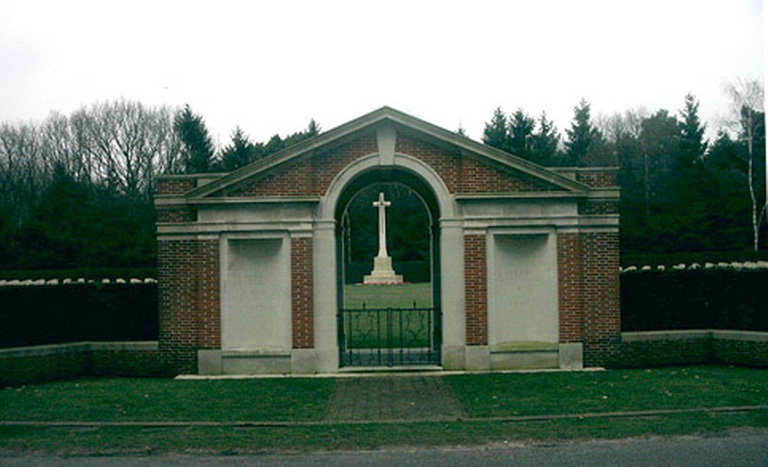
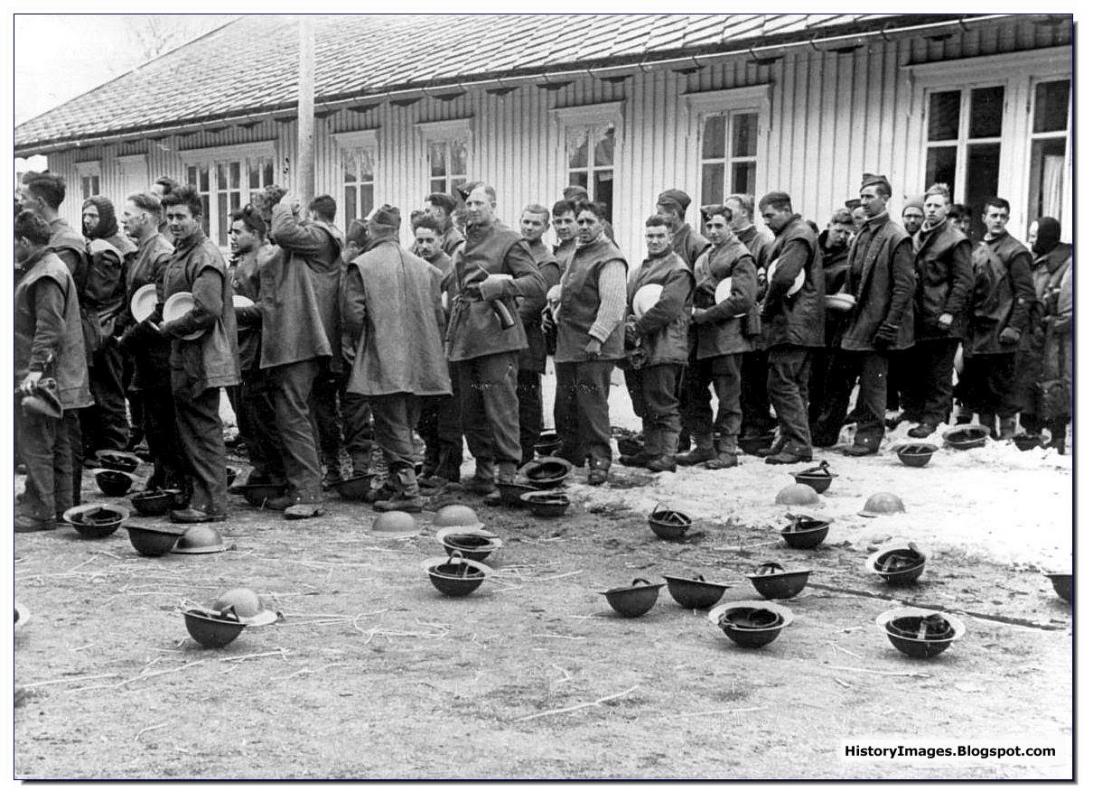
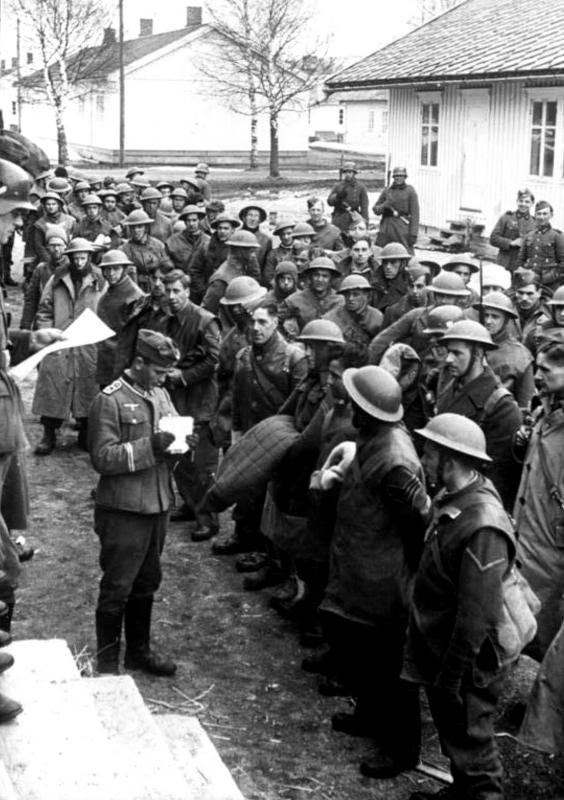 0
0 -
Yes, that's very true, and these are officially named, I'm happy to say. :-)
0 -
I've been waiting to find one of these for a very long time. What a historical addition to the collection!
A 1914-15 Trio to Captain C.A. Bignell, 4th Rajputs, attached 24th Punjabis, a Kut Defender, 1914-15 Star (Capt. 13/Rajputs.); British War and Victory Medals.
Memorial Plaque has been acquired and photos are forthcoming; it's wonderful to reunite groups!
On 29 April 1915, General Townsend surrendered his army. In total, more than 3,000 of those who surrendered at Kut were murdered by the Turks while in captivity and those who survived were little more than skeletons when they were released or exchanged two years later. Overall, the British Army surrendered 227 British and 204 Indian officers and 12,828 other ranks, of which 2,592 were British. The Turks killed more than 1,700 of the British and possibly as many as 3,000 of the Indian troops while in captivity. Losses during the fighting during the siege were approximately 2,000.
Claude Arthur Bignell was born on 10 February 1886, and educated at Dulwich College and Royal Military College, Sandhurst. He was gazetted 2nd Lieutenant in the Indian Army in 1905, being posted in the following year to the 4th Rajputs (Prince Albert Victor's Rajputs, which was attached to the 24th Punjabis) and promoted to Lieutenant in 1907. In 1910 he was appointed an Assistant Instructor at the Musketry School, Satara, and two years later became Quartermaster of his regiment. When war broke out in 1914, he was promoted Captain and saw early service in the German East African campaign (mentioned in despatches).
In August 1915 he was attached to the 24th Punjabis, on service in Mesopotamia, but fell sick before the battle of Ctesiphon in November 1915. He was never fit for duty during the subsequent siege of Kut and died on 21 November 1916, as a prisoner at Yozgad. He is buried in grave XXI H. 4. in the Baghdad (North Gate) War Cemetery, Iraq.
Bignell is specifically mentioned on pages 152 and 153 of Lt. Arthur Valentine Holyoake's (Queen's Own Worcestershire Hussars) book, The Road to Yozgad: My War 1914-1919. He wrote:
"Unfortunately Capt. Bignell our juvenile lead went down with blood poisoning from a scratch during a hockey game and rehearsals (on the play the Fair Maiden of Yozgad) were held up. It was very sad when he became seriously ill and died on 21st November. Our Drs said that if the drugs they had tried to obtain from the Turks had been available, his life could have been saved. This was the first death in the camp and everyone felt very depressed. He was an awfully nice fellow and very popular. We gae him as near to a military funeral as we could manage and he was buried on teh hillside just outside the town... There was an auction of Bignell's efffects and I bought a pair of boots and two towels and a fly net. Some English sovereigns were sold for L2 and L3 each, while two put up as one lot fetched L6. Most of us wanted to have some gold in case of an emergency. The proceeds of the sale were handed to Bignell's family when we returned to England."
YOZGAD (YOZGAT or YUZGAT): This prison camp was located in the Vilayet of Angora in central Anatolia in Asia Minor. The town lay one hundred miles east of Angora and the Turks incarcerated British officers and enlisted men captured at Kut-al-Amara, as well as Russian POW's from the Caucasian Front, in houses inside the city. Prisoners faced a serious influenza epidemic in Yozgad in 1918. The group photo below is of British officers who were PoWs at Yozgad and their exercise area on the road near the houses where they were held captive and then a hockey match. See: http://www.gutenberg-e.org/steuer/steuer/archive/AppendixA/Turkish%20Prison%20Camps/prison_shell.html?Yozgad
Bignell is mentioned here: http://www.mocavo.com/In-Kut-and-Captivity-With-the-Sixth-Indian-Division/357550/58
For information on the North Gate Cemetery in Baghdad, there is an interesting article at this site: http://news.bbc.co.uk/2/hi/middle_east/2974111.stm
Baghdad (North Gate) War Cemetery is located in a very sensitive area in the Waziriah Area of the Al-Russafa district of Baghdad. The main entrance to the cemetery is located opposite the College of Arts and the Institute of Administration in Baghdad University and adjacent to the Iraqi Cigarette Factory in Waziriah Area and the Press of Ministry of Defence.
Visiting Information
NOTE: Whilst the current climate of political instability persists it is not possible for the Commission to manage or maintain its cemeteries and memorials located within Iraq. Alternative arrangements for commemoration have therefore been implemented and a two volume Roll of Honour listing all casualties buried and commemorated in Iraq has been produced. These volumes are on display at the Commission's Head Office in Maidenhead and are available for the public to view.
The Commission continues to monitor the situation in Iraq and once the political climate has improved to an acceptable level the Commission will commence a major rehabilitation project for its cemeteries and commemorations.
Before considering a visit to Iraq the Commission strongly recommends that you check the advice given by the Foreign & Commonwealth Office on the travel section of their website:
www.fco.gov.uk/en/travel-and-living-abroad/travel-advice-by-country/
Historical Information
In 1914, Baghdad was the headquarters of the Turkish Army in Mesopotamia. It was the ultimate objective of the Indian Expeditionary Force 'D' and the goal of the force besieged and captured at Kut in 1916. The city finally fell in March 1917, but the position was not fully consolidated until the end of April. Nevertheless, it had by that time become the Expeditionary Force's advanced base, with two stationary hospitals and three casualty clearing stations.
The North Gate Cemetery was begun In April 1917 and has been greatly enlarged since the end of the First World War by graves brought in from other burial grounds in Baghdad and northern Iraq, and from battlefields and cemeteries in Anatolia where Commonwealth prisoners of war were buried by the Turks.
At present, 4,160 Commonwealth casualties of the First World War are commemorated by name in the cemetery, many of them on special memorials. Unidentified burials from this period number 2,729.
The cemetery also contains the grave of Lieutenant General Sir Stanley Maude, Commander-in-Chief of the Mesopotamian Expeditionary Force, who died at Baghdad in November 1917 and the memorial to the 13th Division which he commanded. A memorial to the 6th Battalion Loyal (North Lancashire) Regiment was brought into the cemetery from the banks of the Diyala River in 1947.
During the Second World War, Baghdad was again an objective of Commonwealth forces. The 20th Indian Infantry Brigade reached the city from Shaiba by the Euphrates route on 12 June 1941 and the 21st Indian Infantry Brigade, part of the 13th Duke of Connaught's Own Lancers, together with the 157th Field Regiment, Royal Artillery, arrived on 19 June via the Tigris. An advanced base was established later near the city and remained in use until 1946.
Most of the 296 Commonwealth servicemen of the Second World War buried in the cemetery died of illness or by accident when serving with PAIFORCE. Again, a number of the graves were brought in from other burial grounds.
Within the cemetery is the Baghdad (North Gate) (Khanaqin) Memorial, commemorating 104 Commonwealth servicemen, 437 Polish soldiers and 3 Arab Legionnaires of the Second World War buried in Khanaqin War Cemetery which, owing to difficulty of access, could not be properly maintained.
The North Gate Cemetery also contains 127 war graves of other nationalities from both wars, 100 of them Turkish, and 41 non-war graves.
For other interesting articles on the cemetery see http://www.ospreypublishing.com/blog/sean_mclachlan_in_iraq/ and http://www.thenational.ae/news/world/middle-east/no-peace-for-the-dead-at-baghdads-restive-north-gate and http://www.telegraph.co.uk/news/worldnews/middleeast/iraq/9975232/Peace-in-Iraq-offers-hope-for-Baghdads-British-war-graves.html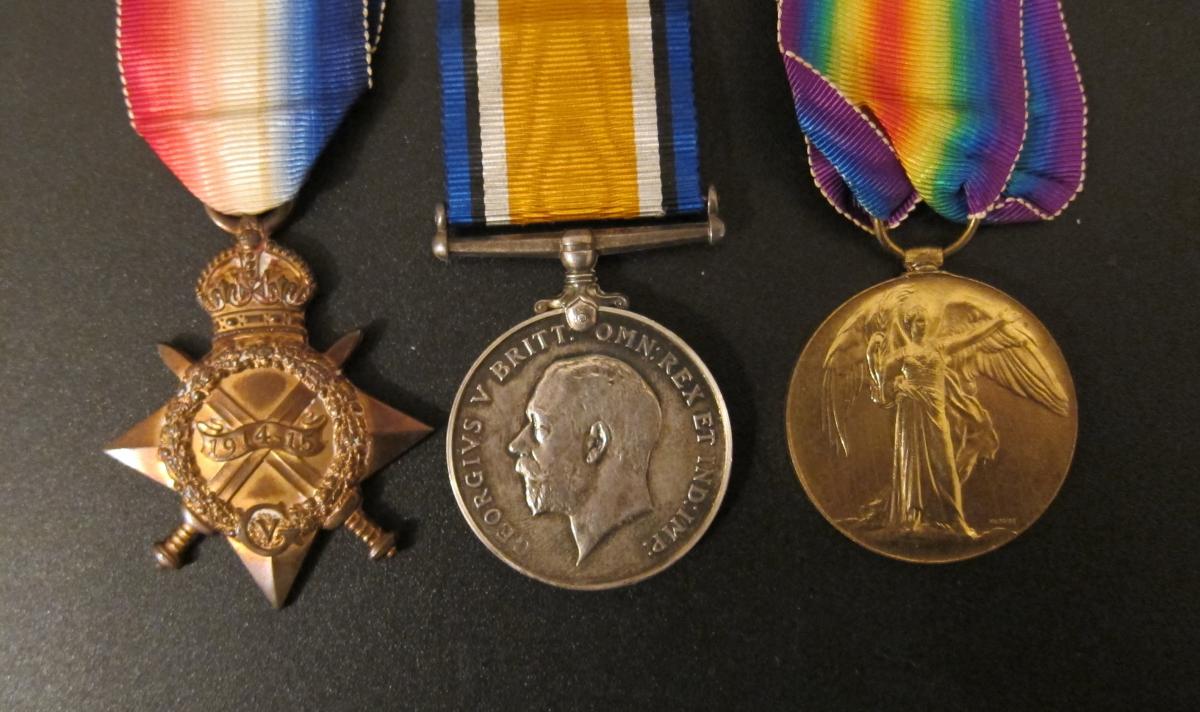
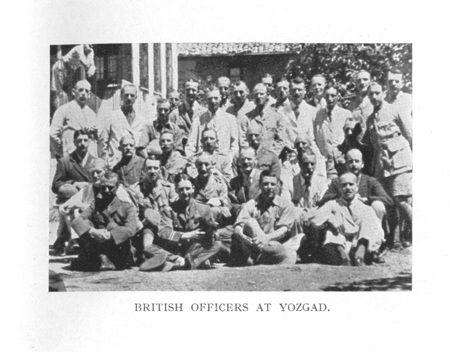
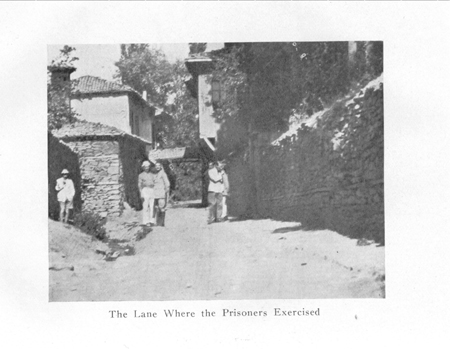
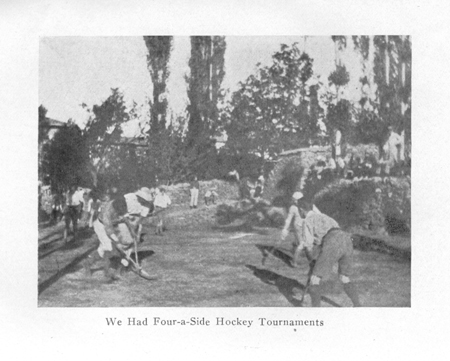
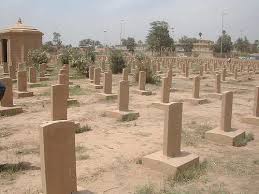


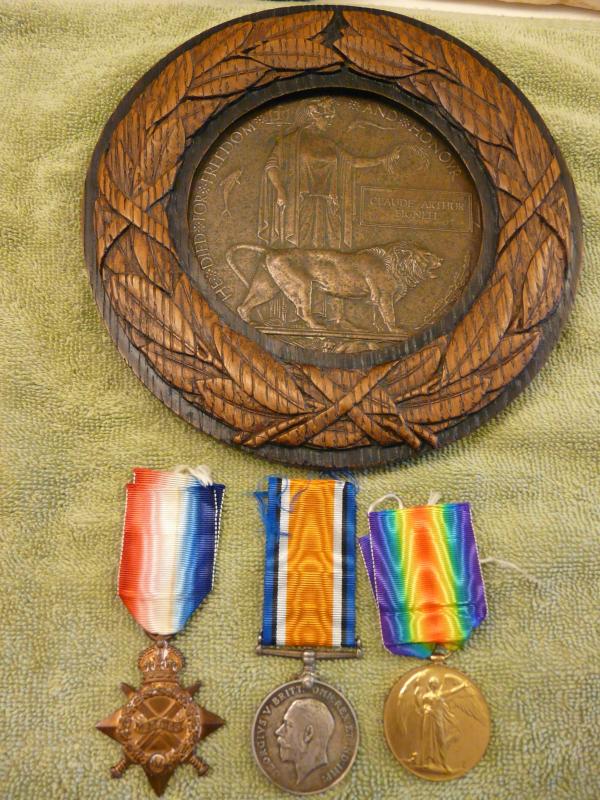 0
0 -
The latest acquisition is a WWI trio consisting of the 1914-15 Star, British War and Victory medals to RMLI prisoner of war.
Officially named to: Ply. 17427 Pte. J. P. McDowell, RMLI (on all medals).
John Patrick McDowell was born in Newry, Ireland in 1895 and enlisted in the RMLI in Belfast in Oct. 1914. He served until 1933 when he was discharged as physically unfit for service.
His papers state that while serving in RM Brigade he was taken prisoner of war on 1st January 1917 and remained as such until Feb. 1919 when returned to Plymouth Div. McDowell was also entitled to a LSGC, which is missing. Please contact if you know its location.
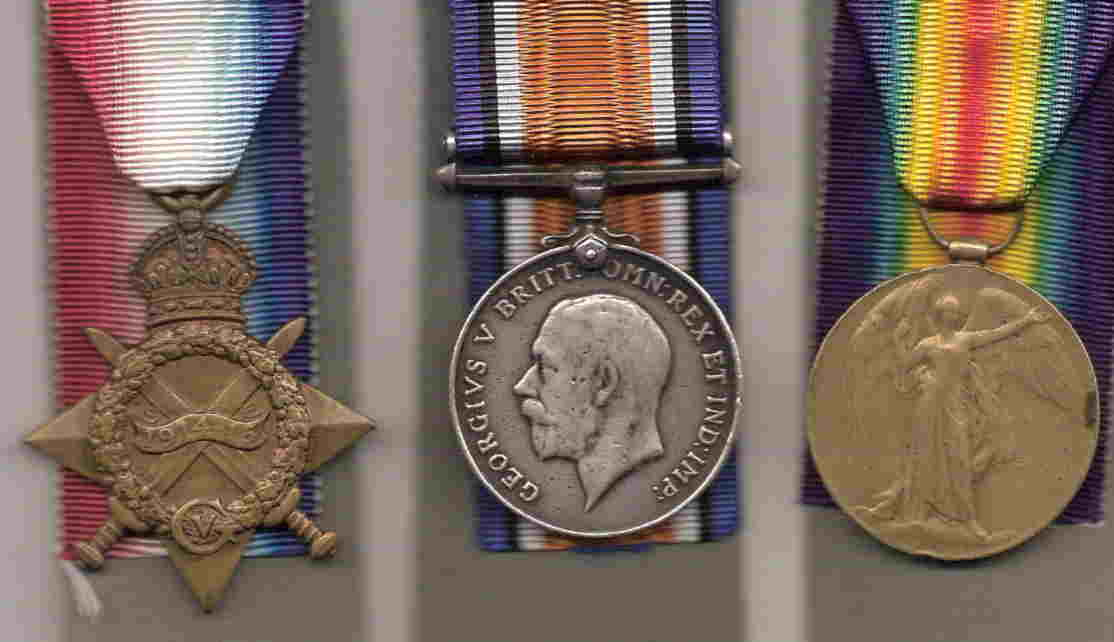
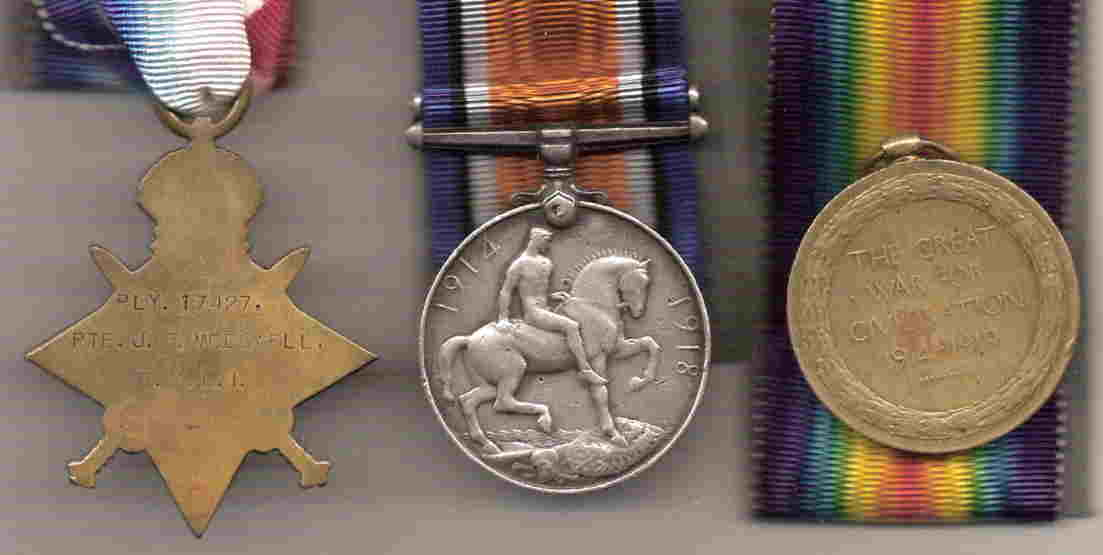 0
0 -
A very fine Korean War Peacekeeping 4th Battalion, Royal Australian Regiment and Vietnam War 5th Battalion, Royal Australian Regiment officer group awarded to Lieutenant Colonel F.J. Spry, Royal Australian Army, who served as second in command of the 5th Battalion in Vietnam during a tour of operations from March 1969 to February 1970, assuming acting command of the Battalion during Operation Camden.
Group of 3: United Nations Medal for Korea, officially impressed naming; (3/35057 F.J. SPRY); Vietnam Medal 1964-1973; (335057 F.J. SPRY); South Vietnam Campaign Medal 1964-1972, with silver 1960 clasp; (335057 F.J. SPRY), mounted court style for display.Korean War Service: 5 July 1954 - 25 April 1955 (295 days) 1st RAR
Vietnam War Service: 8 February 1969-5 March 1970 (391 days) 5 RAR
Spry is in photos and in the book The Year of the Tigers - the Second tour of 5th Battalion, The Royal Australian Regiment in South Vietnam 1969-1970, published 1987
Frederick Joseph Spry was born In Melbourne, Victoria, Australia on 15 January 1933, was originally commissioned as a Lieutenant into the Royal Australian Army when he joined the Australian Staff Corps on 9 December 1953. He saw service in Japan in support of the latter stages of the Korean War and was officially posted to the 4 Battalion, Royal Australian Regiment from 9 December 1953 to 4 July 1954. He was posted to the 1st Recruit Training Battalion from 12 September 1955 to 12 November 1956, and promoted to Temporary Captain from 13 November 1956 to 8 December 1957. He served as Adjutant of the 3rd Infantry Battalion from 13 November 1956 to 28 July 1960. Spry was promoted to Captain in the Australian Staff Corps on 9 December 1957, and then posted to the 3rd Battalion, Royal Australian Regiment from 29 July 1960 to 17th December 1961, being then appointed Staff Captain of "A" Headquarters to Northern Command from 18 December 1961 to 27 June 1963 while attached to the 2nd Battalion, Royal Australian Regiment from 28 June to 19 August 1963. Then Spry was fully posted to the 2nd Battalion from 20 August 1968 to 24 January 1965, having held the rank of Temporary Major from 30 September to 8 December 1963, and promoted to full Major with the Australian Staff Corps on 9 December 1963. Spry was posted to the Australian Staff College from 25 January 1965 to 6 February 1966, and was appointed General Staff Officer 2nd Grade to the Headquarters of the Northern Territories Command from 7 February 1966 to 18 March 1968, and after was posted to the 5th Battalion, Royal Australian Regiment from 19 March 1968 to 17 May 1970, when he served as Battalion Second in Command. It was during his time as Battalion Second in Command that Spry saw service during a tour of operations in South Vietnam, during the 5th Battalion's second tour of operations during the Vietnam War. He is well recorded and in much detail in the book The Year of the Tigers - the Second tour of 5th Battalion, The Royal Australian Regiment in South Vietnam 1969-1970. Spry is recorded in the book on a number of occasions, the book being a fantastic pictorial record of the tour of operations. Spry had in fact been 'given some special treatment by the troops on board H.M.A.S. Sydney during the "Crossing the Equator" fun and games in February 1969 while enroute to Vietnam, and was specifically recorded in a report concerning 'Operation Camden' which lasted from 29th July to 31st August 1969 when 3rd Platoon and the Assault Pioneer Platoon of the 5th RAR encountered the 3rd Battalion of the 274th North Vietnamese Regiment and a fierce action ensued with a number of casualties, and at the height of the action 'Major Fred Spry, the Acting Battalion Commander who had arrived directly overhead in 'Possum' (Bell Sioux Helicopter) and unflinchingly assumed the mantle of the fearless Lieutenant Colonel Colin 'Genghis' Khan, dropped the much needed shell dressings onto the position' - it being at the time impossible to conduct casualty evacuation due to the intense fire. It is clear that Spry was in temporary command of the 5th Battalion at the time. During his period with the 5th Battalion in 1969, it conducted - Operation Quintus Thrust in March - this being a reconnaissance in force operation to prevent enemy forces approaching Baria from the west; Operation Federal Overlander in March, - conducted in order to react to a significant enemy threat to the US bases in the Long Binh and Bien Hoa area; Operation Deerstalk in April - a follow on to the previous operation; Operation Surfside in April - to locate and destroy the Viet Cong D445 Battalion; Operation Twickenham 2 from May to June - to search and destroy in the Nui Bao and Nui Dinh mountains; Operation Hammer in June - the battle of Binh Ba; Operation Tong in June - when C Company attacked the village of Hoa Long; Operation Esso 1, 2 & 3 in July - to counteract the enemy use of mines; Operation Distant Trumpet in July - to disrupt a reported planned offensive by the Viet Cong D445 Battalion; Operation Camden in July to August - conducted in order to protect a US Land Clearing Team and conduct a reconnaissance in force; Operation Kingston in September - in order to locate and destroy D445 Battalion; Operation King's Cross in October to December - to prevent a large scale offensive against Route 15 posts; and finally Operation Bondi 1 & 2 from December 1969 through to February 1970 - this being a cordon and search of the hamlets of Duc Trung, Binh Ba, and Duc My and the return home to Australia. On his return from Vietnam, Spry was appointed to Assistant Quartermaster General at Headquarters of Eastern Command on 18 May 1970, and promoted to Temporary Lieutenant Colonel on the same day. He was fully promoted to Lieutenant Colonel on 31 August 1970, and was afterwards seconded to the Department of Defence Services as an Advisor at Singapore from 5 July 1971. He retired not long afterwards.
In the group photo below, Major Spry, second in command is the fifth officer from the left in the front row. Next, Spry is in the "hot seat" getting special treatment while crossing the equator on his way to Vietnam in the second photo. In the photo on board HMAS Sydney, Maj. Spry is the officer on the far left. The photo was taken at Garden Island on 10 March 1970.
Here is 5RAR's operational list for 1969-70: http://www.5rar.asn.au/ops/opslist2.htm
For more information on Operation Camden, please see: http://www.5rar.asn.au/narrative/op-camden-2.htm
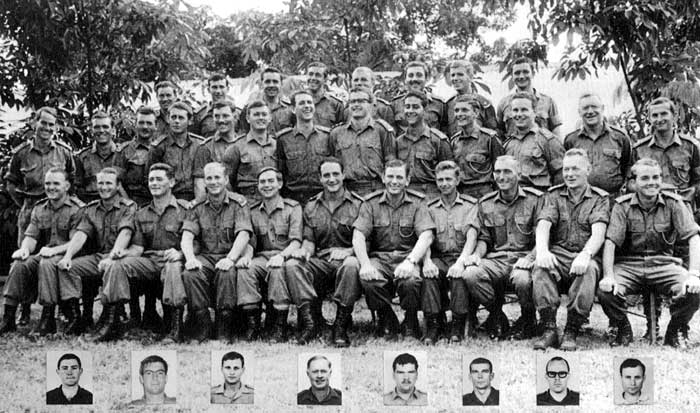

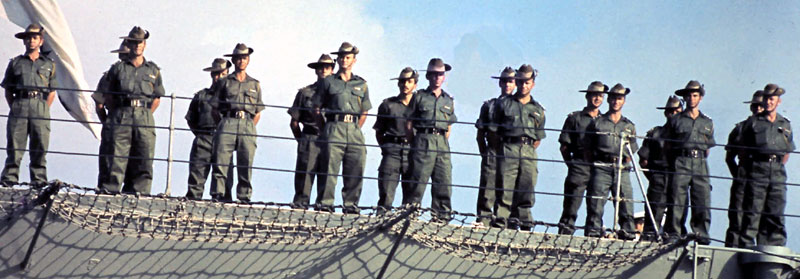 0
0 -
Excellent research and congratulations on resurrecting this man for us all to appreciate! Best regards, John
0 -
The latest acquisition is an important PoW pair to: Pte. Thomas Tulloch, 2nd Royal Highlanders (Black Watch) who was taken prisoner of war at Magersfointein on 11th December 1899.Queen’s South Africa 1899-1902, (ghost dates) 3 clasps: Cape Colony, Orange Free State, Transvaal 6632 Pte. T. Tulloch, 2nd Rl. Highldrs.
King’s South Africa 1901-02, 2 clasps 6634 Pte., Rl. Highrs. (Royal Highlanders)
According to the rolls, he transferred into the 1st Bn. later on and thus, the two numbers.In this important Boer War Black Week and Black Watch action, 53 were taken Prisoner of War. Their losses were about 44% and consisted of the Colonel, six other Officers, 88 men K.I.A. 11 Officers, 207 men wounded. Note the good photograph of the RH PoWs marching in captivity; I wonder if Tulloch is one of them?
FootnotePossibly the same man as 1834 Private Thomas Tulloch, 7th Battalion Royal Scots, who enlisted on 30 August 1914 and was discharged on 13 January 1916 and was awarded the Silver War Badge. He was discharged due to injuries sustained at the Gretna (Quintinshill) railway disaster on 22 May 1915. 226 men were killed in the disaster, of which 217 were men of the Royal Scots who were aboard a troop train. A further 246 men were injured.
Confirmation of Tulloch being one of the Black Watch PoWs is at: www.blackwatch.50megs.com/magsprison.html
For excellent, well-written information on this action by the 2Bn. R Highlanders, please go to: www.blackwatch.50megs.com/mags.html
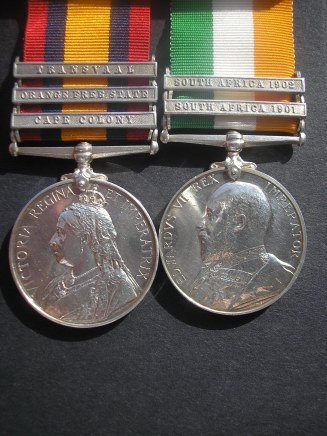
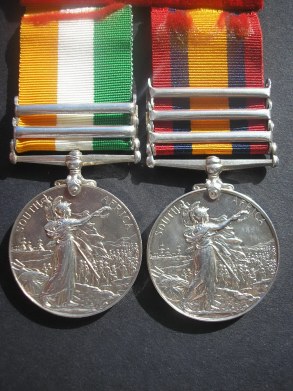
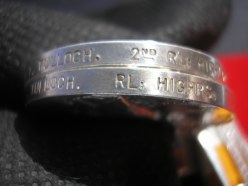


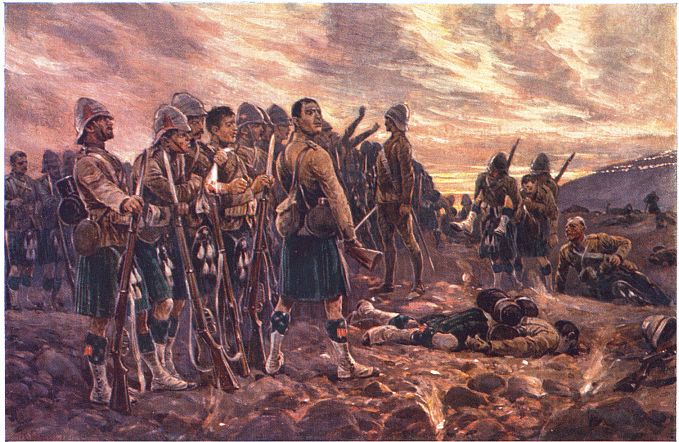
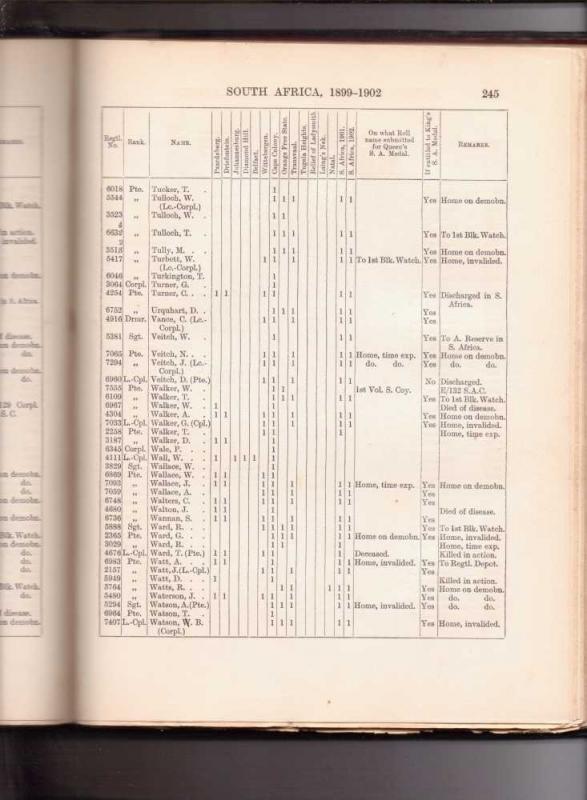 0
0 -
An interesting photo that somewhat goes along with the entries on the above swords.
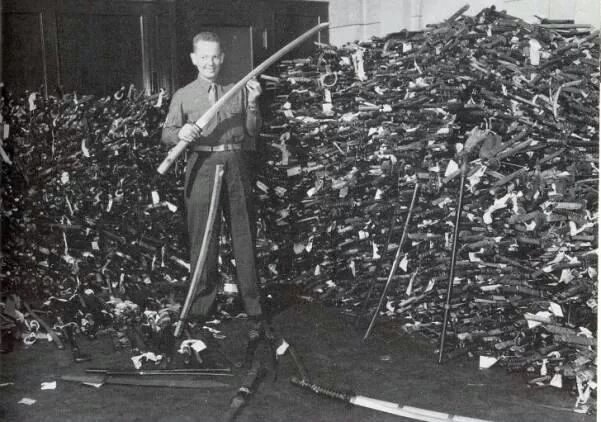 0
0 -
Very nice. Thank you. Who are the men in the back and what was the occassion?
0 -
My great uncle was awarded the exact same bar along with a black wound badge after having served as a balloonist in WWI.
0 -
A very finely made Meybauer bar that is IDed with the recipient's name on the EK2C.
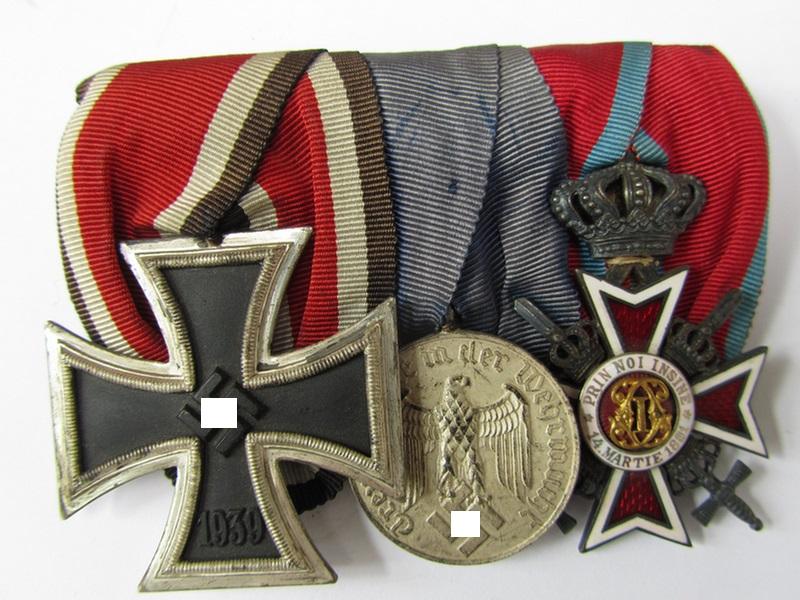
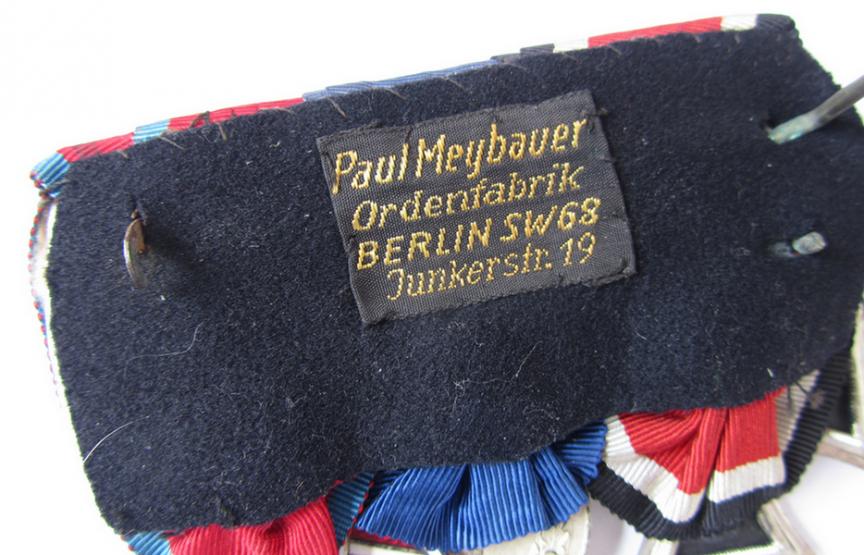
 0
0 -
Another QSA acquired with Cape Colony, Orange Free State transvaal ans SA1901 clasps to:
6750 Pte. W. Patterson, 2nd Northumberland Fusiliers and who was captured on 12 December, 1900 at Nooitgedacht, Transvaal and released a few days later.
In Lord Roberts' despatch of 10th October 1900, dealing with the escape of De Wet from the Brandwater basin and the steps taken to pursue him, his lordship mentions that the 2nd Northumberland Fusiliers were about the end of July taken from the garrison of Bloemfontein and put into a brigade under Hart, who was then assisting to enclose De Wet in the Reitzburg Hills (see 1st Northumberland Fusiliers). In September 1900 the brigade of General Clements was broken up, and he was given a column to operate in the Megaliesberg range, chiefly between Rustenburg and Krugersdorp. His force consisted of the 2nd Northumberland Fusiliers, 2nd Worcestershire Regiment, 1st Border Regiment, 2nd Yorkshire Light Infantry, 900 mounted troops under Colonel Ridley, and the 8th Battery RFA. Much hard and useful work was done, but, as a rule, the enemy retired and would not fight. He was waiting for an opportunity, which came in December, when Clements was out with only a part of his force, and the Boers had been able to gather a very large body. The words of the despatch are: "General Clements' force, which had encamped immediately south of Nooitgedacht Pass (in the Megaliesberg Mountains, NW of Pretoria), was attacked before daylight on 13th December 1900 by the combined forces of Delarey and Beyers. Four companies of the Northumberland Fusiliers, who were holding the ridges overlooking the camp, were surrounded and captured by the enemy. The loss of the outpost rendered the camp untenable, and though the Boers suffered heavy loss in pressing home their attack, General Clements found himself obliged to fall back on Commando Nek". The attacking force was probably about 4000. The losses of the Fusiliers in killed and wounded were about 100, and neither Lord Kitchener nor General Clements seemed to be at all dissatisfied with the defence made; and it is satisfactory to know that 1 officer and 12 men were mentioned in despatches for exceptional gallantry.
The Battle of Nooitgedacht started when Gen. Koos de la Rey and Christian Beyerscmbined forces to oppose Maj. General R.A.P. Clements' British Brigade on 13 December 1900. The In the pre-dawn, Boer commandos blundered into British picket lines. There was a brief close-range fire fight during which the Boers were driven back. There were loses on both sides. The British, now alerted, manned their defensive positions and the Royal Northumberland Fusiliers sturdy resistance stopped Beyer's renewed attack by his tired men on the mountain top. De la Rey initially attacked in the below valley and then Beyer's men stormed the British positions. After around 100 casualties, Capt. Yatman surrendered at about 7AM that morning. The British counter-attacked and drove the Boers from Yeomanry Hill. Some of the RNFs were released a couple of days later on 15 December, 1900.
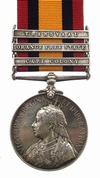 0
0 -
Medal group of six:
The Most Honourable Order of the Bath, C.B., Military, Companion’s breast badge in gold and enamels, hallmarked London with maker’s mark 'BD', complete with wide swivel ring and straight suspension and gold ribbon buckle, Sultan's Medal for Egypt 1801, 4th class, Gold 36mm with gold chain and straight bar suspender, Field Officer's Gold Medal 1808 - 1814 for Vittoria, Bar: St Sebastian (MAJOR CHARLES CAMPBELL), Military General Service Medal 1793 - 1814, Bar: Corunna (C. S. CAMPBELL, C.B., CAPT., 26th FOOT), Portuguese Peninsula War Cross for 2 campaigns, English pattern in silver gilt with swivel ring and straight bar suspender, Portuguese Commander's Medal for 2 actions, circular gold medal with two green enamelled lozenges inscribed Vittoria and St Sebastian with gold swivel ring and straight bar suspender.
Charles Stuart Campbell was born in New York, America, on 12 April 1779. He was aged 17 upon his first appointment to the Army on 7 December 1796 as an Ensign in the 26th Foot, being advanced to Lieutenant in December 1797, to Captain in May 1804, and to Brevet Major in September 1813. He served in Canada from 1796 to 1800, and in Egypt in 1801-02.
Campbell next served with the 26th Foot in Portugal and Spain in 1808-09, including the battle of Corunna, where he commanded the piquets of his brigade. Later in 1809 he took part in the expedition to Walcheren and the siege of Flushing. Returning to the Peninsula in 1811, Campbell commanded the 3rd Portuguese Regiment at the battle of Vittoria, and also at the siege and assault of St Sebastian, being severely wounded in the thigh at the assault, the ball remaining lodged.
He was mentioned in Graham’s St Sebastian dispatch, dated Oyarzun, 1 September 1813 (Major Charles Stuart Campbell, commanding the 3rd Regiment in Colonel M'Crae's absence on general duty), and also in Lord Lyndoch’s dispatch and Marshal Lord Beresford’s order of the day. In respect of his wound at St Sebastian he received one years pay and a Pension of £250, and was appointed a Major by Brevet in the 26th Foot and a Lieutenant-Colonel in the Portuguese Army.
Campbell was promoted to Lieutenant-Colonel in the 26th Foot in 1822, and in the same rank in the 1st Foot (Royal Scots) on 24 January 1829. Created a Companion of the Bath on 26 September 1831, he was placed on Half-pay in October 1838, was promoted to Colonel in November 1841 and to Major-General in June 1854. Campbell died at Reading on 30 August 1854.
The Army Gold Medal St Sebastian clasp is an excellent quality contemporary copy.
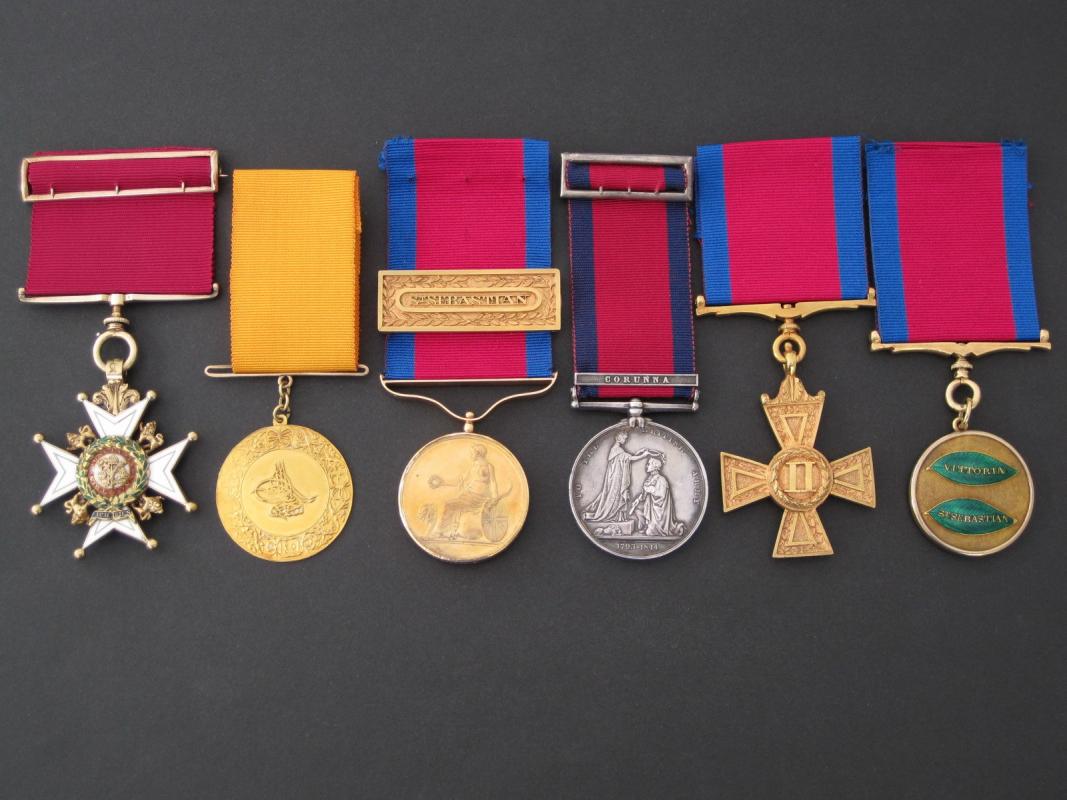
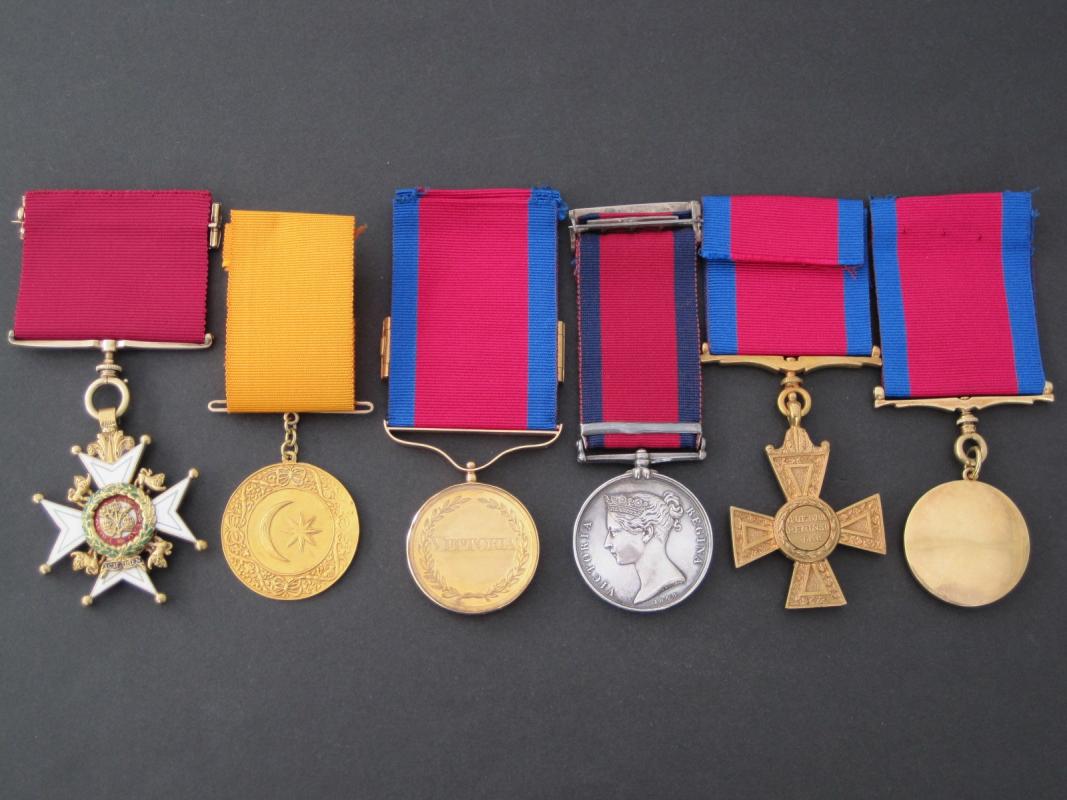 0
0



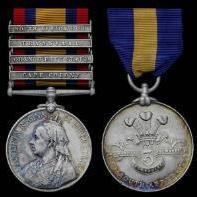
German bits and bobs...
in Germany: Imperial: The Orders, Decorations and Medals of The Imperial German States
Posted · Edited by azyeoman
Haven't added anything to this collection in a very long time, but have just acquired an interesting very long service group with all the paperwork to a man who went up quite high in the postal service later on in life. It's the accompanying paper work that make it nice and interesting.